Microsoft RM-260 GSM850/900/1800/1900 UMA phone w/BTand WLAN User Manual 6086 9255565 13Nov06
Microsoft Mobile Oy GSM850/900/1800/1900 UMA phone w/BTand WLAN 6086 9255565 13Nov06
Contents
- 1. Manual
- 2. Manual insert
Manual

1
Nokia 6086 User Guide
9255565
Issue 1

2
LEGAL INFORMATION
The crossed-out wheeled bin means that within the European Union the product
must be taken to separate collection at the product end-of-life. This applies to
your device but also to any enhancements marked with this symbol. Do not
dispose of these products as unsorted municipal waste. For more information, see
product Eco-Declaration or country specific information at www.nokiausa.com.
Part No. 9255565, Issue No. 1
Copyright © 2006 Nokia. All rights reserved.
Reproduction, transfer, distribution or storage of part or all of the contents in this document
in any form without the prior written permission of Nokia is prohibited.
Nokia, Nokia Connecting People, Pop-Port, PC Suite, and the Nokia Original Enhancements
logos are trademarks or registered trademarks of Nokia Corporation. Other product and
company names mentioned herein may be trademarks or tradenames of their respective
owners.
Nokia tune is a sound mark of Nokia Corporation.
US Patent No 5818437 and other pending patents. T9 text input software Copyright (C)
1997-2006. Tegic Communications, Inc. All rights reserved.
Includes RSA BSAFE cryptographic or security protocol software from RSA
Security.
JavaTM and all Java-based marks are trademarks or registered trademarks of Sun
Microsystems, Inc.
Bluetooth is a registered trademark of Bluetooth SIG, Inc.
This product is licensed under the MPEG-4 Visual Patent Portfolio License (i) for personal and
noncommercial use in connection with information which has been encoded in compliance
with the MPEG-4 Visual Standard by a consumer engaged in a personal and noncommercial
activity and (ii) for use in connection with MPEG-4 video provided by a licensed video
provider. No license is granted or shall be implied for any other use. Additional information,
including that related to promotional, internal, and commercial uses, may be obtained from
MPEG LA, LLC. See <http://www.mpegla.com>.
Nokia operates a policy of ongoing development. Nokia reserves the right to make changes
and improvements to any of the products described in this document without prior notice.
TO THE MAXIMUM EXTENT PERMITTED BY APPLICABLE LAW, UNDER NO CIRCUMSTANCES
SHALL NOKIA OR ANY OF ITS LICENSORS BE RESPONSIBLE FOR ANY LOSS OF DATA OR
INCOME OR ANY SPECIAL, INCIDENTAL, CONSEQUENTIAL OR INDIRECT DAMAGES
HOWSOEVER CAUSED.

3
THE CONTENTS OF THIS DOCUMENT ARE PROVIDED "AS IS". EXCEPT AS REQUIRED BY
APPLICABLE LAW, NO WARRANTIES OF ANY KIND, EITHER EXPRESS OR IMPLIED, INCLUDING,
BUT NOT LIMITED TO, THE IMPLIED WARRANTIES OF MERCHANTABILITY AND FITNESS FOR A
PARTICULAR PURPOSE, ARE MADE IN RELATION TO THE ACCURACY, RELIABILITY OR
CONTENTS OF THIS DOCUMENT. NOKIA RESERVES THE RIGHT TO REVISE THIS DOCUMENT OR
WITHDRAW IT AT ANY TIME WITHOUT PRIOR NOTICE.
This device complies with Directive 2002/95/EC on the restriction of the use of certain
hazardous substances in electrical and electronic equipment.
The availability of particular products may vary by region. Please check with the Nokia dealer
nearest to you.
Export Controls
This device may contain commodities, technology, or software subject to export laws and
regulations from the U.S. and other countries. Diversion contrary to law is prohibited.
FCC/INDUSTRY CANADA NOTICE
Your device may cause TV or radio interference (for example, when using a telephone in close
proximity to receiving equipment). The FCC or Industry Canada can require you to stop using
your telephone if such interference cannot be eliminated. If you require assistance, contact
your local service facility. This device complies with part 15 of the FCC rules. Operation is
subject to the following two conditions: (1) This device may not cause harmful interference,
and (2) this device must accept any interference received, including interference that may
cause undesired operation. Any changes or modifications not expressly approved by Nokia
could void the user's authority to operate this equipment.

4
Contents
For your safety.......................... 6
General information................. 9
Access codes............................................ 9
Copyright protection.......................... 10
Configuration settings service ........ 10
Download content and
applications .......................................... 10
1. Get started ......................... 12
Install the SIM card and battery .... 12
Charge the battery.............................. 13
Memory card installation ................. 13
Switch the phone on and off........... 14
Open the fold ....................................... 15
Normal operating position ............... 15
Antenna ................................................. 16
Wrist strap ............................................ 16
2. Your phone......................... 17
Keys and parts...................................... 17
Standby mode ...................................... 18
Indicators and icons........................... 20
Keys lock (keyguard) .......................... 21
3. Call functions..................... 23
Make a call ........................................... 23
1-touch dialing.................................... 23
Enhanced voice dialing...................... 23
Answer or decline a call.................... 24
Options during a call.......................... 24
4. Phone menus...................... 26
Menu views........................................... 26
Access a menu function.................... 26
5. Messaging .......................... 27
Text messages ...................................... 27
SIM messages....................................... 30
Multimedia messages ........................ 30
Nokia Xpress audio messaging........ 33
Instant messaging............................... 34
E-mail application .............................. 38
Voice messages.................................... 41
Info messages ...................................... 41
Service commands.............................. 41
Delete messages.................................. 41
Message settings................................. 42
6. Contacts.............................. 45
Search .................................................... 45
Save names and phone numbers.... 45
Save numbers, items, or an image. 45
Copy a contact..................................... 46
Edit contact details ............................ 46
Delete contacts or details................. 46
Business cards...................................... 46
Settings.................................................. 47
Groups.................................................... 47
1-touch dialing.................................... 47
Service and my numbers................... 47
7. Call log................................ 48
Positioning information .................... 48
8. Settings............................... 49
Profiles ................................................... 49
Themes ................................................... 49
Tones....................................................... 49
Display.................................................... 50
Time and date ...................................... 51
My shortcuts ........................................ 52
Connectivity ......................................... 53
Call.......................................................... 62
Phone...................................................... 62
Enhancements ..................................... 64
Configuration....................................... 64
Security.................................................. 65
Restore factory settings.................... 66

5
Phone software updates.................... 66
9. Operator menu ................... 67
10.Gallery ............................... 68
Format memory card .......................... 68
11.Media ................................ 69
Camera ................................................... 69
Media player ......................................... 70
Music player.......................................... 70
Radio ....................................................... 72
Recorder ................................................. 73
Equalizer................................................. 74
Stereo widening................................... 74
12.Push to talk....................... 75
Connect and disconnect.................... 75
Make and receive a PTT call ............. 75
Callback requests................................. 77
Add a one-to-one contact................ 78
PTT channels ......................................... 78
PTT settings ........................................... 79
13.Organizer........................... 81
Alarm clock............................................ 81
Calendar................................................. 81
To-do list................................................ 82
Notes....................................................... 83
Calculator .............................................. 83
Timer ....................................................... 83
Stopwatch ............................................. 84
14.Applications...................... 85
Games ..................................................... 85
Collection............................................... 85
15.Web.................................... 87
Technology background..................... 87
Service provider ................................... 87
Access service....................................... 87
Browse.................................................... 88
Security settings .................................. 90
Bookmarks ............................................. 90
Download settings .............................. 91
Service inbox ........................................ 91
Cache memory...................................... 91
Browser security .................................. 92
16.SIM services....................... 95
17.Computer connectivity ..... 96
USB data storage................................. 96
Nokia PC Suite...................................... 96
EGPRS, GPRS, HSCSD, and CSD ....... 96
Data communication applications . 96
Bluetooth............................................... 97
18.Enhancements ................... 98
19.Battery information.......... 99
Charging and discharging................. 99
Nokia battery authentication
guidelines............................................ 100
Care and maintenance ........ 102
Additional safety
information.......................... 103
Index..................................... 108
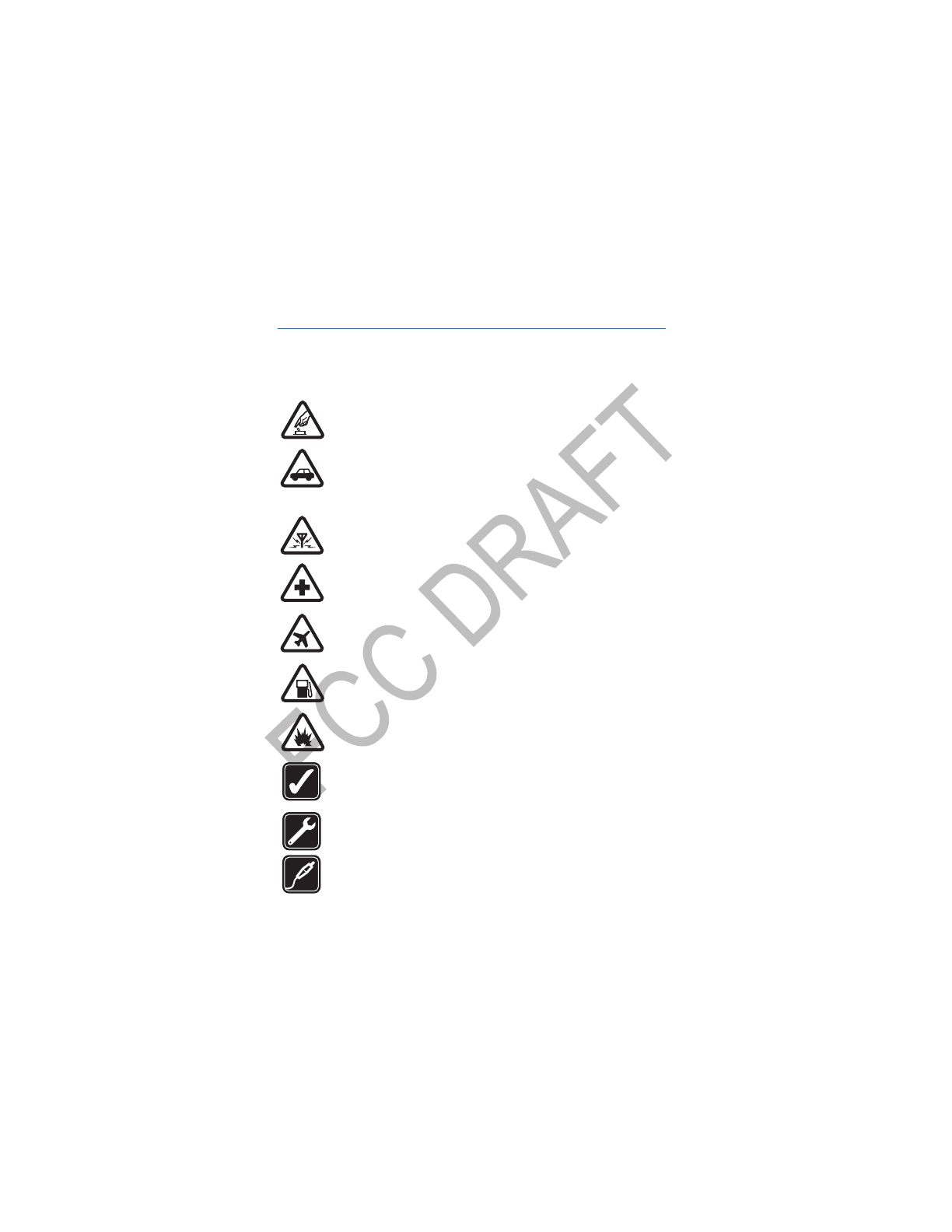
For your safety
6
For your safety
Read these simple guidelines. Not following them may be dangerous or illegal.
Read the complete user guide for further information.
SWITCH ON SAFELY
Do not switch the phone on when wireless phone use is prohibited or
when it may cause interference or danger.
ROAD SAFETY COMES FIRST
Obey all local laws. Always keep your hands free to operate the
vehicle while driving. Your first consideration while driving should be
road safety.
INTERFERENCE
All wireless phones may be susceptible to interference, which could
affect performance.
SWITCH OFF IN HOSPITALS
Follow any restrictions. Switch the phone off near medical
equipment.
SWITCH OFF IN AIRCRAFT
Follow any restrictions. Wireless devices can cause interference in
aircraft.
SWITCH OFF WHEN REFUELING
Do not use the phone at a refueling point. Do not use near fuel or
chemicals.
SWITCH OFF NEAR BLASTING
Follow any restrictions. Do not use the phone where blasting is in
progress.
USE SENSIBLY
Use only in the normal position as explained in the product
documentation. Do not touch the antenna unnecessarily.
QUALIFIED SERVICE
Only qualified personnel may install or repair this product.
ENHANCEMENTS AND BATTERIES
Use only approved enhancements and batteries. Do not connect
incompatible products.

For your safety
7
WATER-RESISTANCE
Your phone is not water-resistant. Keep it dry.
BACK-UP COPIES
Remember to make back-up copies or keep a written record of all
important information stored in your phone.
CONNECTING TO OTHER DEVICES
When connecting to any other device, read its user guide for detailed
safety instructions. Do not connect incompatible products.
EMERGENCY CALLS
Ensure the phone is switched on and in service. Press the end key as
many times as needed to clear the display and return to the start
screen. Enter the emergency number, then press the call key. Give
your location. Do not end the call until given permission to do so.
■About your device
The wireless device described in this guide is approved for use on the GSM 850,
900, 1800, and 1900 networks. Contact your service provider for more
information about networks.
When using the features in this device, obey all laws and respect the privacy and
legitimate rights of others, including copyrights.
When taking and using images or video clips, obey all laws and respect local
customs as well as privacy and legitimate rights of others.
Warning: To use any features in this device, other than the alarm clock,
the device must be switched on. Do not switch the device on when
wireless device use may cause interference or danger.
■Network services
To use the phone you must have service from a wireless service provider. Many of
the features in this device depend on features in the wireless network to
function. These network services may not be available on all networks or you may
have to make specific arrangements with your service provider before you can
utilize network services. Your service provider may need to give you additional
instructions for their use and explain what charges will apply. Some networks
may have limitations that affect how you can use network services. For instance,
some networks may not support all language-dependent characters and services.
Your service provider may have requested that certain features be disabled or not
activated in your device. If so, they will not appear on your device menu. Your

For your safety
8
device may also have been specially configured. This configuration may include
changes in menu names, menu order, and icons. Contact your service provider for
more information.
This device supports WAP 2.0 protocols (HTTP and SSL) that run on TCP/IP
protocols. Some features of this device, such as multimedia messaging service
(MMS), browsing, e-mail application, instant messaging, remote
synchronization, and content downloading using the browser or MMS, require
network support for these technologies.
■Shared memory
The following features in this device may share memory: gallery, contacts, text
messages, multimedia messages, instant messages, e-mail, calendar, to-do notes,
and JavaTM games and applications. Use of one or more of these features may
reduce the memory available for the remaining features sharing memory. For
example, saving many Java applications may use all of the available memory.
Your device may display a message that the memory is full when you try to use a
shared memory feature. In this case, delete some of the information or entries
stored in the shared memory features before continuing. Some of the features,
such as text messages, may have a certain amount of memory specially allotted
to them in addition to the memory shared with other features.
■Enhancements
Check the model number of any charger before use with this device. This device is
intended for use when supplied with power from the AC-3 charger. This device
uses BL-5C batteries.
Warning: Use only batteries, chargers, and enhancements approved by
Nokia for use with this particular model. The use of any other types may
invalidate any approval or warranty, and may be dangerous.
For availability of approved enhancements, please check with your dealer.
A few practical rules about accessories and enhancements
• Keep all accessories and enhancements out of the reach of small children.
• When you disconnect the power cord of any accessory or enhancement, grasp
and pull the plug, not the cord.
• Check regularly that enhancements installed in a vehicle are mounted and
are operating properly.
• Installation of any complex car enhancements must be made by qualified
personnel only.

General information
9
General information
Congratulations on your purchase of this Nokia mobile phone. Some of its other
features include a calendar, a clock, an alarm clock, a radio, a music player, and a
built-in camera.
■Access codes
Security code
The security code (5 to 10 digits) helps to protect your phone against
unauthorized use. The preset code is 12345. To change the code, and to set the
phone to request the code, see “Security,” p. 65.
If you enter an incorrect security code five times in succession, the phone ignores
further entries of the code. Wait for five minutes, and enter the code again.
PIN codes
The personal identification number (PIN) code and the universal personal
identification number (UPIN) code (4 to 8 digits) help to protect your SIM card
against unauthorized use. See “Security,” p. 65. The PIN code is usually supplied
with the SIM card. To set the phone to request the PIN code, see “Security,” p. 65.
The PIN2 code (4 to 8 digits) may be supplied with the SIM card and is required
for some functions.
The module PIN is required to access the information in the security module. See
“Security module,” p. 92. The module PIN is supplied with the SIM card if the SIM
card has a security module in it.
The signing PIN is required for the digital signature. See “Digital signature,” p. 93.
The signing PIN is supplied with the SIM card if the SIM card has a security
module in it.
PUK codes
The personal unblocking key (PUK) code and the universal personal unblocking
key (UPUK) code (8 digits) are required to change a blocked PIN code and UPIN
code, respectively. The PUK2 code is required to change a blocked PIN2 code. If
the codes are not supplied with the SIM card, contact your service provider for
the codes.

General information
10
Restriction password
The restriction password (4 digits) is required when using Call restrictions. See
“Security,” p. 65. You can obtain the password from your service provider.
If you enter an incorrect restriction password three times in succession, the
password is blocked. Contact your service provider for assistance.
■Copyright protection
Copyright protections may prevent some images, music (including ringing tones),
and other content from being copied, modified, transferred, or forwarded.
■Configuration settings service
To use some of the network services, such as mobile internet services, MMS, or
remote internet server synchronization, your phone needs the correct
configuration settings. You may be able to receive the settings directly as a
configuration message. After receiving the settings, you must save them on your
phone. The service provider may provide a PIN that is needed to save the settings.
For more information on availability of the settings, contact your service
provider.
When you receive a configuration message, Configuration sett. received is
displayed.
To save the settings, select Show >Save. If the phone requests Enter settings'
PIN:, enter the PIN code for the settings, and select OK. To receive the PIN code,
contact the service provider that supplies the settings. If no settings are saved,
these settings are saved and set as default configuration settings. Otherwise, the
phone asks Activate saved configuration settings?
To discard the received settings, select Show > Discard.
To edit the settings, see “Configuration,” p. 64.
■Download content and applications
You may be able to download content (for example, themes, tones, and video
clips) to the phone (network service). Select the download function (for example,
in the Gallery menu). To access the download function, see the respective menu
descriptions.
For the availability of different services, pricing, and fees, contact your service
provider.

General information
11
Important: Use only services that you trust and that offer adequate
security and protection against harmful software.

Get started
12
1. Get started
■Install the SIM card and battery
Always switch the device off, and disconnect the charger before removing the
battery.
Keep all SIM cards out of the reach of small children.
For availability and information on using SIM card services, contact your SIM
card vendor. This may be the service provider, network operator, or other vendor.
The SIM card and its contacts can easily be damaged by scratches or bending, so
be careful when handling, inserting, or removing the card.
To install the SIM card:
1. Press firmly and slide the top of the back
cover to release it; then remove the back
cover by lifting it from the phone.
2. After you have removed the back cover,
insert your fingernail under the battery,
and lift it as shown.
3. Place a fingernail in the middle of the
metal SIM card holder. Then, unlatch and
swing the SIM card holder open.
4. Insert the SIM card into the holder as
shown, beveled corner first, with the gold-
colored contacts on the SIM card face up
(away from the phone).
5. Swing the SIM card holder closed. The
gold-colored contacts on the SIM card
meet the gold-colored contacts on the inside of the phone. Gently press the
SIM card holder into the phone until it clicks into place.
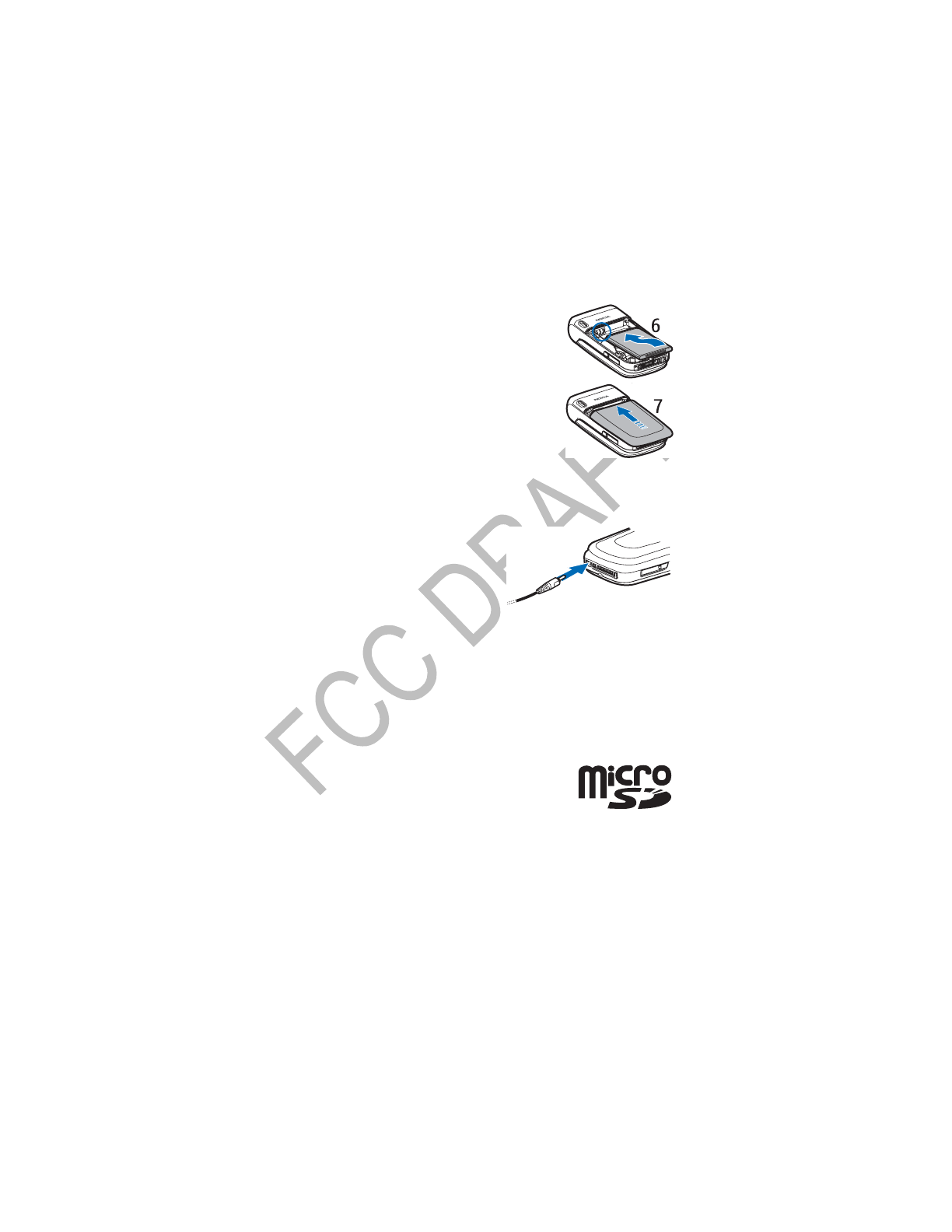
Get started
13
6. Replace the battery, by positioning it (with the
label side facing up), so the gold-colored contacts
match up with those on the phone. Slide the
battery in until it snaps into place.
7. Slide the back cover until it locks into place.
■Charge the battery
1. Connect the charger to a standard wall
outlet.
2. Insert the charger plug into the round
jack in the bottom of the phone. If the
battery is completely discharged, it
may take a few minutes before the
charging indicator appears on the
display or before any calls can be made.
3. Disconnect the charger from the phone
when the battery is fully charged.
You can use the phone while the charger is connected. The charging time
depends on the charger and the battery used. For example, charging a BL-5C
battery with the AC-3 charger takes approximately 2 hours and 20 minutes while
the phone is in the standby mode.
■Memory card installation
Keep all microSD memory cards out of the reach of small
children.
Use only compatible microSD cards approved by Nokia for use with this device.
Nokia uses approved industry standards for memory cards, but some brands may
not be fully compatible with this device. Incompatible cards may damage the
card and the device and corrupt data stored on the card.
You can use a memory card to extend the memory of the Gallery. See “Gallery,”
p. 68. You can insert or change the memory card without turning the phone off.
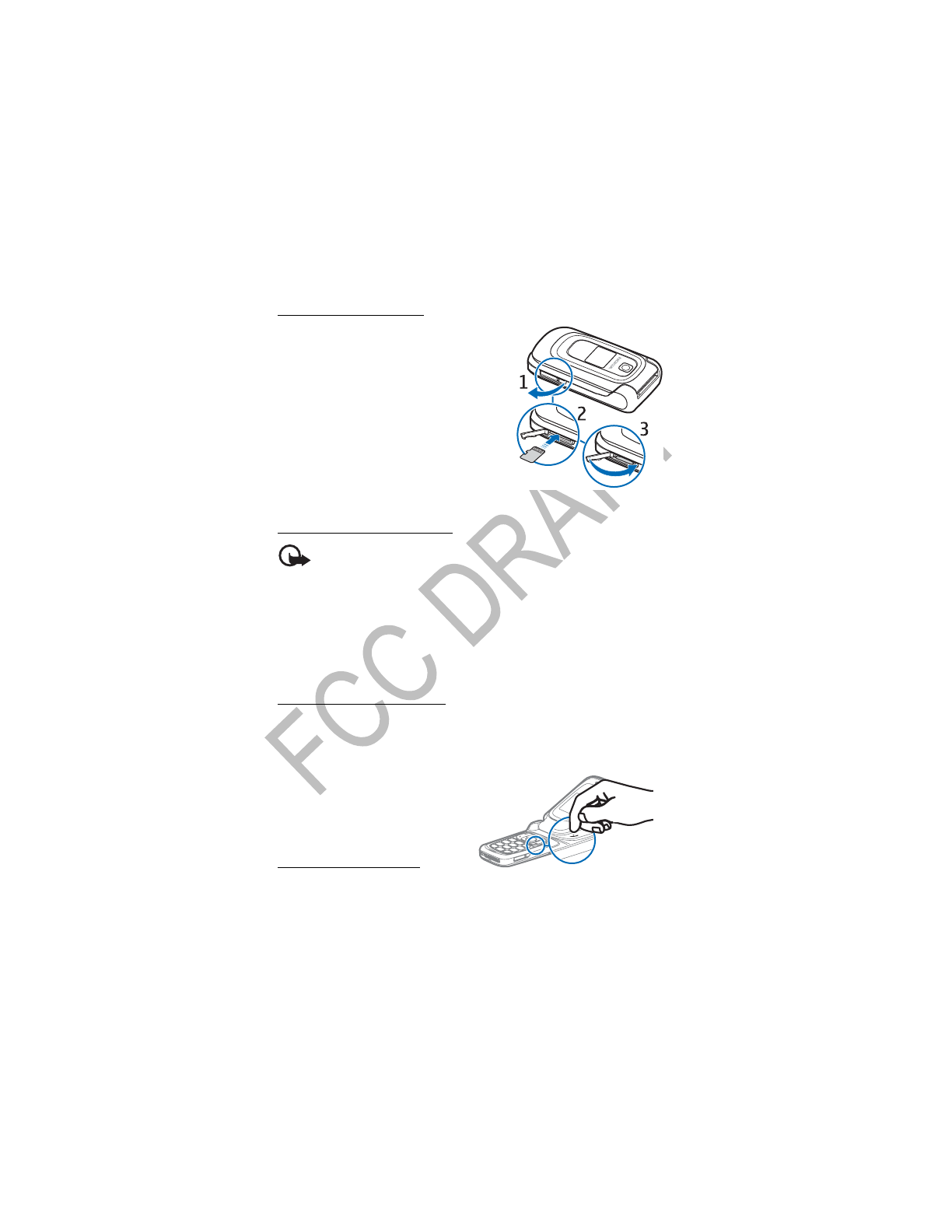
Get started
14
Insert a microSD card
To insert a memory card, use a fingernail as a
lever, place it in the recessed area of the
memory card holder, and swing the holder
open (1). Place the memory card in the card
holder (2). Make sure that the memory card is
properly inserted and that the gold-colored
contacts on the card are facing upwards. Close
the memory card holder (3).
You can use the memory card to save your
multimedia files, such as video clips, sound
files, and images, in the Gallery.
Remove the microSD card
Important: Do not remove the memory card in the middle of an
operation when the card is being accessed. Removing the card in the
middle of an operation may damage the memory card as well as the
device, and data stored on the card may be corrupted.
To remove the memory card, use a fingernail as a lever, place it in the recessed
area of the memory card holder, and swing the holder open. Push gently with a
fingernail against the card to loosen it from the holder. Pull the card out. Close
the memory card holder.
Format the memory card
To format the memory card, see “Format memory card,” p. 68.
■Switch the phone on and off
Press and hold the end key until the
phone switches on or off. If the phone
asks for a PIN, enter the code, and
select OK.
Plug and play service
When you turn on your phone for the
first time and the phone is in the standby mode, you are prompted to get the
configuration settings from your service provider (network service). Confirm or
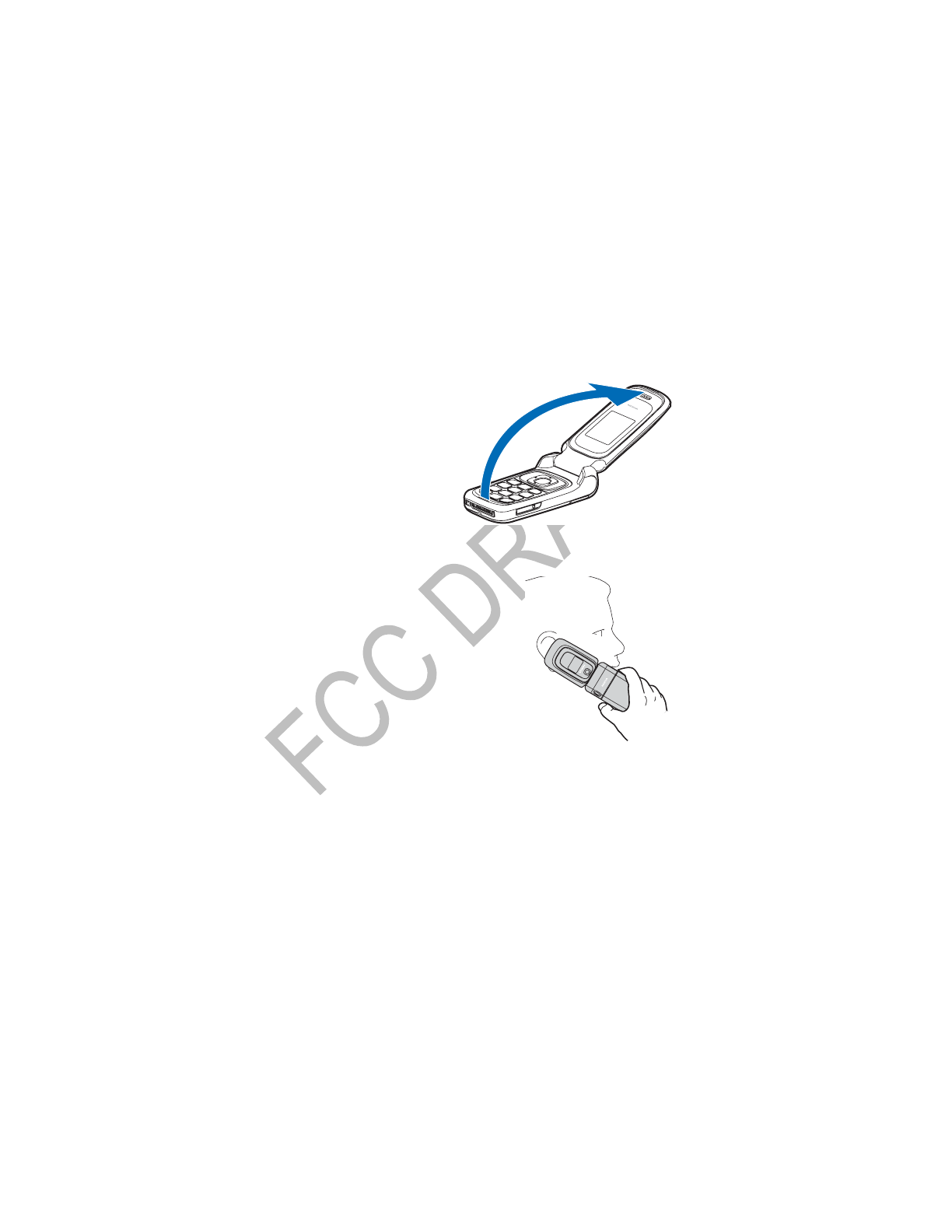
Get started
15
decline the query. See Connect to service provider support in “Configuration,”
p. 64 and “Configuration settings service,” p. 10.
■Open the fold
When you open the fold of the
phone, it opens up to
approximately 155 degrees. Do
not try to force the fold open
more.
■Normal operating position
Use the phone only in its normal operating
position.
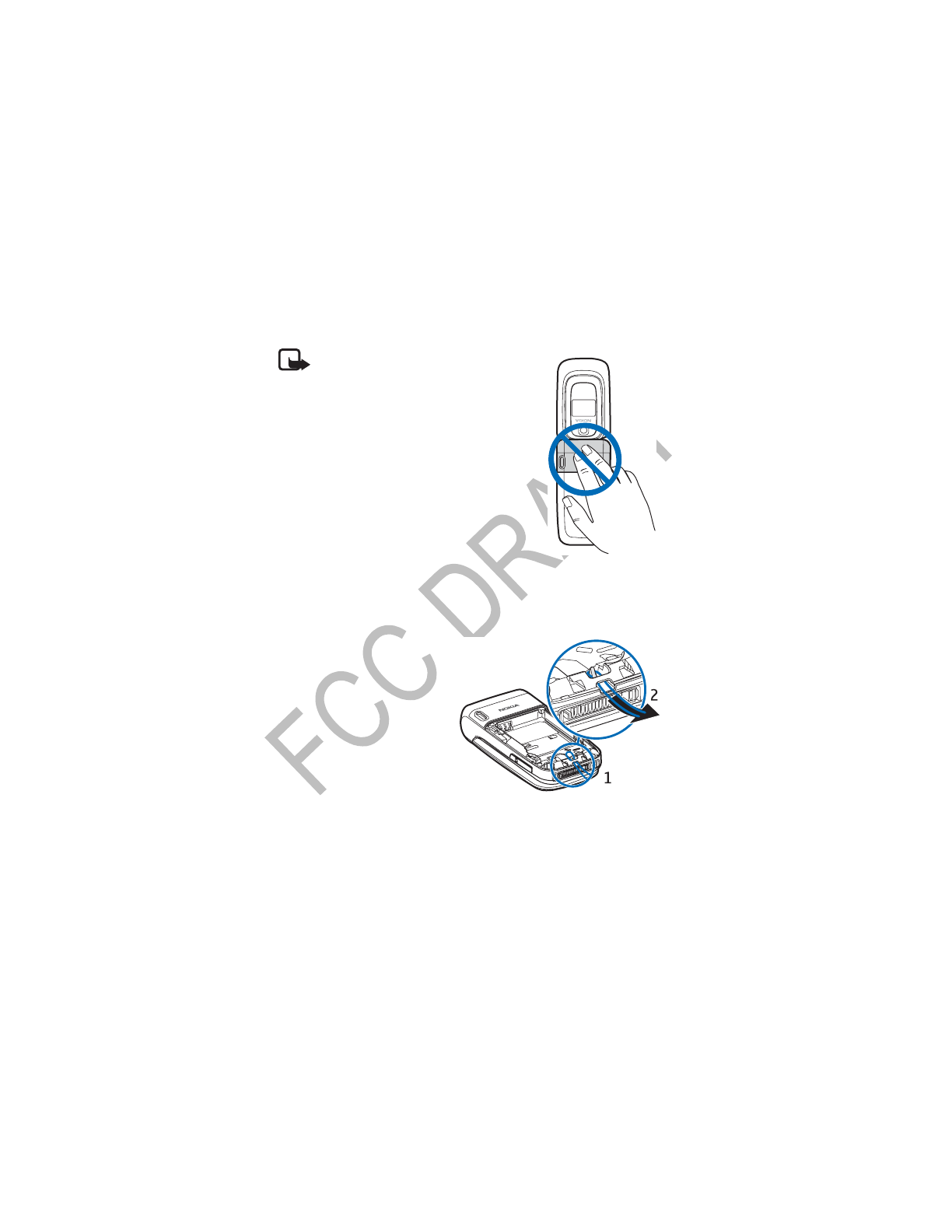
Get started
16
■Antenna
Your device has an internal antenna.
Note: As with any other radio
transmitting device, do not touch the
antenna unnecessarily when the device is
switched on. Contact with the antenna
affects call quality and may cause the
device to operate at a higher power level
than otherwise needed. Avoiding contact
with the antenna area when operating the
device optimizes the antenna
performance and the battery life.
■Wrist strap
To attach a wrist strap to the phone, remove the back cover from the phone and
thread a strap as shown in the picture.
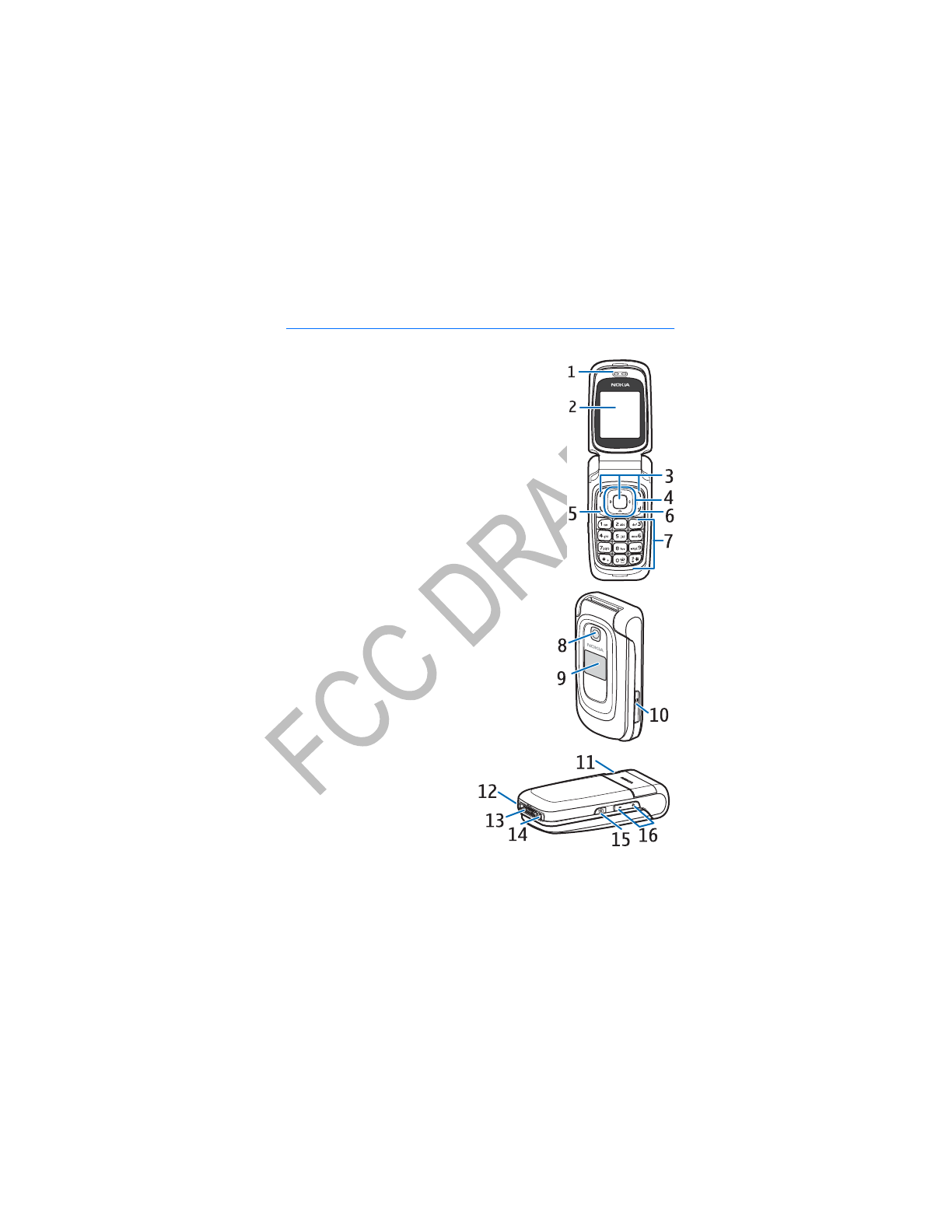
Your phone
17
2. Your phone
■Keys and parts
Earpiece (1)
Main display (2)
Left, middle, and right selection keys (3)
Four-way navigation key (4)
Call key (5)
End key (6)
Keys (7)
Camera lens (8)
Mini display (9)
Memory card holder (10)
Loudspeaker (11)
Microphone (12)
Pop-Port connectorTM (13)
Charger connector (14)
Camera release key (15)
Volume key and push to talk key (16)
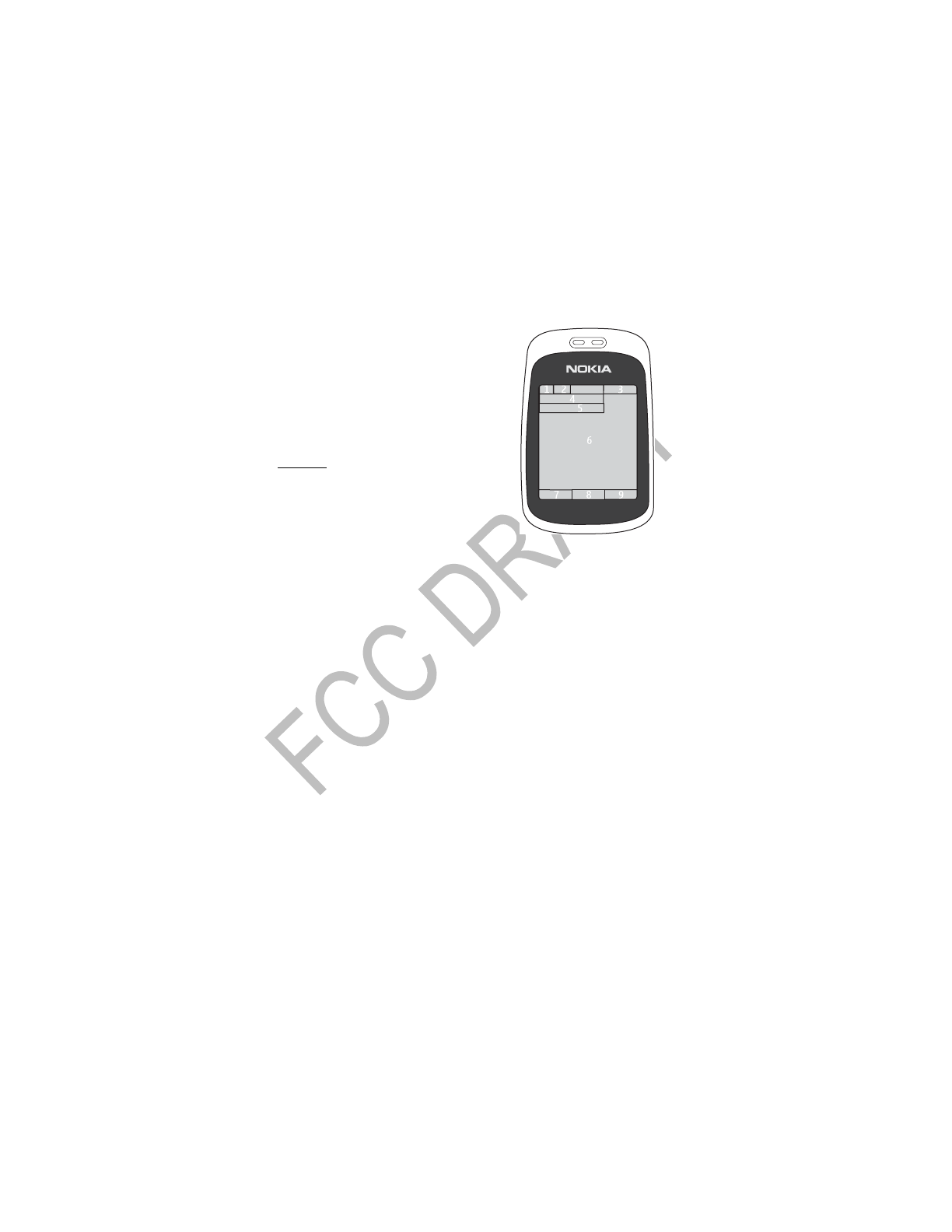
Your phone
18
■Standby mode
When you turn on your phone, the first screen
that appears is the start screen, which
indicates your phone is in the standby mode.
When your phone is in the standby mode, the
selection keys access specific functions, and
the indicators appear on the start screen.
Indicators show the status of the phone.
Display
• Network signal strength (1)
• Battery charge status (2)
• Clock (3) — If the time is set to appear on
the display. See “Time and date,” in
“Settings,” p. 51.
• Name of the service provider or the operator logo (4)
• Calendar (5) — The date is displayed if it is set to appear on the display and
the active standby is not set. See “Active standby mode,” p. 19 and “Time and
date,” p. 51.
• Active standby (6) — See “Active standby mode,” on p. 19.
• Left selection key (7) — Go to or a shortcut to another function. See “Left
selection key,” p. 52.
• Middle selection key (8) — Menu.
• Right selection key (9) — May be Names to access the list of contacts in the
Contacts menu, an operator specific name to access an operator specific web
site, or a shortcut to a function that you selected. See “Right selection key,”
p. 52.
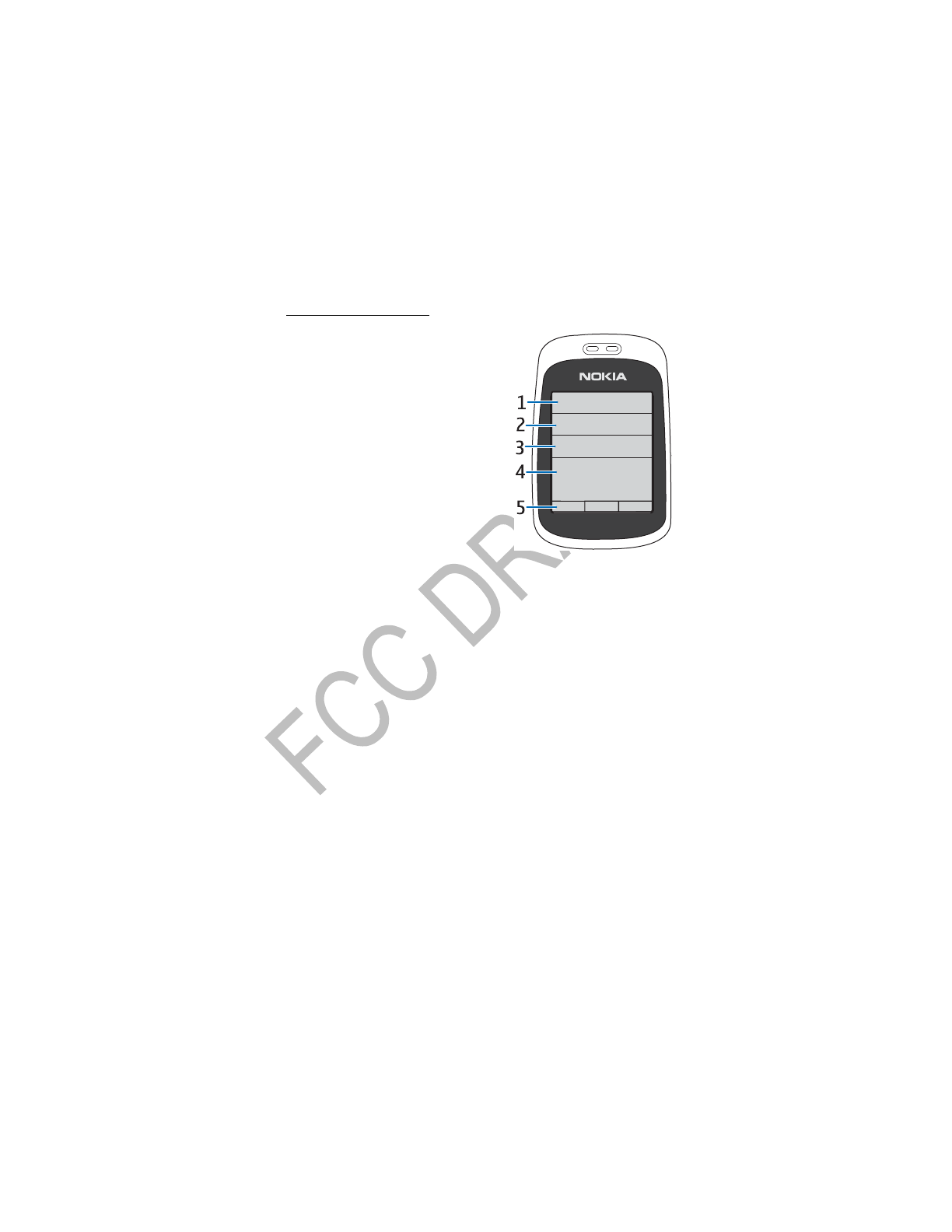
Your phone
19
Active standby mode
In the active standby mode, the phone can
display separate content item windows,
such as general indicators and operator
logo (1), shortcuts (2), audio functions (3),
and the calendar (4).
To select whether the active standby is
shown, see Active standby in “Standby
mode settings,” p. 50. The active standby is
in passive mode when the middle selection
key (5) is Menu; you can only view content.
To activate the navigation mode and scroll
through the content, use the navigation
key.
To change the key for accessing the
navigation mode, see Active standby key in
“Standby mode settings,” p. 50. When the arrow indicators are shown, you can
scroll the item left and right.
To personalize and organize the active standby content, select Options, and
select a corresponding option. See “Standby mode settings,” p. 50.
To exit the navigation mode, select Exit. If no keys are pressed after a certain
period of time, the phone automatically returns to the passive mode.
Content items in navigation mode
Shortcut bar — To select a shortcut, scroll to the function you want, and select it.
To change or organize the shortcuts when in the navigation mode, select
Options > Personalize.
Radio and Music — To turn on the radio or the music player, scroll to and select it.
To change a track in the music player, scroll down or up. To start the radio
channel search, scroll and hold left or right.
Calendar — To view today’s notes, select the one you want. To view the notes for
the previous or next days, scroll left or right.
My note — To enter a note, select the content window, write your note, and save
it.
Countdown timer — To start the countdown timer, select the content item. The
remaining time with a note is shown.

Your phone
20
General indicators — To show standby indicators, such as date, cell info display,
info messages, PTT default group name, and closed user group index. The date is
shown if the calendar is not selected as active standby content.
Standby mode shortcuts
To access the list of dialed numbers, press the call key once. See “Make a call,”
p. 23.
To call your voice mailbox (network service) when you have saved your voice
mailbox number in the phone, press and hold 1.
To connect to a browser service, press and hold 0.
To set shortcut functions for the navigation key, see Navigation key in “My
shortcuts,” p. 52.
To make a call by pressing a number key with an assigned phone number, see
“1-touch dialing,” p. 23.
To toggle between the Normal profile and the Silent profile, press and hold #.
■Indicators and icons
Your phone has two types of identifiers: indicators and icons.
Indicators
See “Standby mode,” p. 18 for information on indicators.
Icons
Icons are graphical representations of a specific item or situation. The following
list describes each icon.
You have unread messages in the Inbox folder.
You have unsent, canceled, or failed messages in the Outbox folder.
The phone logged a missed call.
You received one or several instant messages and you are connected to
the instant messaging service.
The keys are locked.
The alarm clock is set to On.

Your phone
21
The phone does not ring for an incoming call or text message.
The countdown timer is running.
The stopwatch is running in the background.
/The phone is registered to the GPRS or EGPRS network.
/A GPRS or EGPRS connection is established.
/The GPRS or EGPRS connection is suspended (on hold), for example, if
there is an incoming or outgoing call during an EGPRS or GPRS dial-up
connection.
A Bluetooth connection is active.
If you have two phone lines, the second phone line is selected.
All incoming calls are forwarded to another number.
The loudspeaker is activated or the music stand is connected to the
phone.
Calls are limited to a closed user group.
The timed profile is selected.
Calls are routed over a wireless local network (WLAN)/wireless fidelity
(Wi-Fi). See “WLAN/Wi-Fi,” p. 53.
■Keys lock (keyguard)
The keyguard disables the keys to prevent accidental keypresses.
• To lock the keys, select Menu and press * within 3.5 seconds.
• To unlock the keys, select Unlock and press * within 1.5 seconds.
• To enable automatic keyguard, select Menu >Settings > Phone > Automatic
keyguard > On. Set the delay in minutes and seconds in which the keys lock.
If the Security keyguard is set to On, enter the security code, if requested.
To answer a call when the keyguard is on, press the call key. When you end or
decline the call, the keys automatically lock.
When the keyguard is on, calls to the official emergency number programmed
into your device may still be possible. Enter the emergency number and press the
call key.

Your phone
22
For information about Security keyguard, see “Phone,” p. 62.

Call functions
23
3. Call functions
■Make a call
1. Enter the phone number, including the area code. To delete an incorrect
character, select Clear.
For international calls, press * twice for the international prefix (the +
character replaces the international access code), then enter the country
code, the area code without the leading 0, if necessary, and the phone
number.
2. To call the number, press the call key.
3. To end the call or to cancel the call attempt, press the end key, or select
Options > End call.
■1-touch dialing
Assign a phone number to one of the 1-touch-dialing keys, 2 to 9. Call the
number by one of the following ways:
• Press a 1-touch-dialing key, then press the call key.
•If 1-touch dialing is set to On, press and hold a 1-touch-dialing key until the
call begins. See 1-touch dialing in “Call,” p. 62.
■Enhanced voice dialing
To make a phone call, say the name that is saved in the contact list of the phone.
A voice command is added automatically to all entries in the contact list of the
phone.
Make a voice dialing call
If an application is sending or receiving data using a packet data connection, end
the application before you use voice dialing.
Voice commands are language-dependent. To set the language, see Voice
recognition language in “Phone,” p. 62.

Call functions
24
Note: Using voice tags may be difficult in a noisy environment or during
an emergency, so you should not rely solely upon voice dialing in all
circumstances.
1. In the standby mode, press and hold the right selection key. A short tone is
played and Speak now is displayed.
If you are using a compatible headset with the headset key, press and hold
the headset key to start the voice dialing.
2. Say the voice command clearly. If the voice recognition is successful, a list of
matches is shown. The phone plays the voice command of the match on the
top of the list. After about 1.5 seconds, the phone dials the number or, if the
result is not the correct one, scroll to another entry, and select to dial the
entry.
Using voice commands to carry out a selected phone function is similar to
voice dialing. See Voice commands in “My shortcuts,” p. 52.
■Answer or decline a call
To answer the call, open the fold or press the call key. To mute the ringing tone if
the fold is open, select Silence or, if the fold is closed, press the volume up or
down key.
To decline an incoming call if the fold is open, press the end key.
If Forward if busy is activated in your voice mailbox, the call is forwarded to your
voice mail. If not, the call is declined.
To answer and end a call if a compatible headset (supplied with the headset key)
is connected to the phone, press the headset key.
Call waiting
Call waiting is a network service. To answer the waiting call during an active call,
press the call key. The first call is put on hold. To end the active call, press the end
key.
To activate the Call waiting function, see “Call,” p. 62.
■Options during a call
Many of the options that you can use during a call are network services. For
availability, contact your service provider.

Call functions
25
To increase or decrease the volume during a call, press the volume up or down key
on the side of the phone.
Select Options during a call and the following options may be available.
Touch tones — to send tone strings
Swap — to switch between the active call and the call on hold
Transfer calls — to connect a call on hold to an active call and disconnect yourself
Conference — to make a conference call that allows up to five persons to take
part in a conference call
Private call — to discuss privately in a conference call.
Warning: Do not hold the device near your ear when the loudspeaker is
in use because the volume may be extremely loud.

Phone menus
26
4. Phone menus
Phone features are grouped according to function and are accessed through the
main menus of your phone. Each main menu contains submenus and lists from
which you can select or view items and personalize phone features. Scroll to
access these menus and submenus.
Some menus may not be available, depending on your network. For more
information, contact your service provider.
■Menu views
Your phone may have two types of menu views: List and Grid.
In the List interface, images introduce every menu. Scroll to navigate through the
menus. As you scroll through the menus, the menu number appears in the upper
right corner of the display. Below the menu number is a scroll bar with a tab. The
tab moves up or down as you scroll through the menus, providing a visual
representation of your current position in the menu structure.
In the Grid interface, multiple menu icons appear on a single display. Use the
four-way navigation key to scroll through the icons. The name of the menu
appears at the top of the display and the icon for the selected menu is outlined.
To change the menu view, select Menu > Options > Main menu view > List or
Grid.
■Access a menu function
1. Select Menu and the menu you want.
2. If the menu contains submenus, select the one that you want.
3. If the selected menu contains further submenus, select the one that you want
4. To return to the previous menu level, select Back. To exit the menu, select
Exit.

Messaging
27
5. Messaging
You can use mobile messages to keep in touch with friends,
family, and business associates by using the short message service (SMS), which
is a network service. Not all messaging features are available in all wireless
networks. Contact your service provider for availability and subscription
information.
When sending messages, your phone may display the words Message sent. This is
an indication that the message has been sent by your device to the message
center number programmed into your device. This is not an indication that the
message has been received at the intended destination. For more details about
messaging services, check with your service provider.
■Text messages
Your device supports the sending of text messages beyond the character limit for
a single message. Longer messages are sent as a series of two or more messages.
Your service provider may charge accordingly. Characters that use accents or
other marks, and characters from some language options, such as Chinese, take
up more space, which limits the number of characters that can be sent in a single
message.
You can use predefined templates to help you write text messages. Before you
can send any text or e-mail messages, you need to configure the message
settings. See “Message settings,” p. 42.
To check SMS e-mail service availability and to subscribe to the service, contact
your service provider.
Text entry
To enter text while writing messages, use traditional or predictive text input.
When using traditional text input, press a number key, 1 to 9, repeatedly until
the character you want is displayed. In predictive text input you can enter a letter
with a single keypress.
When you write text, appears at the top left of the display, which indicates
predictive text input, and is displayed, which indicates traditional text input.
, , or is displayed next to the text input indicator, which indicates
the character case. To change the character case, press #. indicates number

Messaging
28
mode. To change from the letter to number mode, press and hold #, and select
Number mode.
Settings
To set the writing language to a different language, select Options > Writing
language. Predictive text input is only available for the languages listed.
To set the predictive text input option, select Options > Prediction on, or to set
traditional text input option, select Options > Prediction off.
To quickly set predictive text input on or off when writing text, press # twice, or
select and hold Options.
Predictive text input
Predictive text input allows you to write text quickly by using the phone keys and
a built-in dictionary.
1. Start writing a word, using the keys 2 to 9, and press each key only once for
one letter. The word changes after each keystroke.
2. When you finish writing the word and it is correct, press 0.
3. If a displayed word is not correct, press * repeatedly, or select Options >
Matches. When the word that you want is displayed, select Use.
4. If the ? character is displayed after the word, the word you intended to write
is not in the dictionary. To add the word to the dictionary, select Spell. The
phone displays the entered letters. Enter the word (traditional text input is
used), and select Save.
Traditional text input
Press a number key, 1 to 9, repeatedly until the character you want is displayed.
Not all characters available under a number key are printed on the key. The
characters available depends on the selected writing language. See “Settings,”
p. 28.
If the next letter you want is located on the same key as the current one, wait
until the cursor is displayed or scroll and enter the letter.
To access the most common punctuation marks and special characters, press 1.
To insert a space, press 0.
If you want more characters, press *.

Messaging
29
Write and send
1. Select Menu > Messaging > Create message > Text message and enter the
recipient’s phone number in the To: field.
2. To retrieve a phone number from Contacts, select Add > Contact. To send the
message to multiple recipients, add the contacts you want one by one.
3. To send the message to persons in a group, select Contact group and the
group you want. To retrieve the contacts to which you recently sent
messages, select Add > Recently used.
4. Scroll down and enter a message. See “Text entry,” p. 27.
5. To insert a template to the text message, select Options > Use template and
the template you want to insert.
6. To see how the message will look to the recipient, select Options > Preview.
7. To send the message, select Send.
Read and reply
When you receive messages, either 1 message received or N messages received is
displayed, where N is the number of new messages.
1. To view a new message, select Show. To view it later, select Exit.
To read the message later, select Menu > Messaging > Inbox. If more than
one message has been received, select the message that you want to read.
indicates an unread message in Inbox.
2. While reading a message, select Options and delete or forward the message,
edit the message as a text message or an SMS e-mail or move it to another
folder, or view or extract message details. You can also copy text from the
beginning of the message to your phone calendar as a reminder note.
3. To reply to a message, select Reply > Text message, Multimedia, Flash
message, or Audio message.
To send a text message to an e-mail address, enter the e-mail address in the
To: field.
4. Scroll down and enter a message in the Message: field. See “Text entry,” p. 27.
To change the message type for your reply message, select Options > Change
msg. type.

Messaging
30
5. To send the message, select Send.
■SIM messages
SIM messages are text messages that are saved to your SIM card. You can copy or
move those messages to the phone memory, but not vice versa. Received
messages are saved to the phone memory.
To read SIM messages, select Menu > Messaging > Options > SIM messages.
■Multimedia messages
Note: Only devices that have compatible features can receive and
display multimedia messages. The appearance of a message may vary
depending on the receiving device.
A multimedia message can contain text, sound, a picture, a calendar note, a
business card, or a video clip. If the message is too large, the phone may not be
able to receive it. Some networks allow text messages that include an internet
address where you can view the multimedia message.
You cannot receive multimedia messages during a call or an active browsing
session over GSM data. Because delivery of multimedia messages can fail for
various reasons, do not rely solely upon them for essential communications.
Write and send a multimedia message
The wireless network may limit the size of multimedia messages. If the inserted
image exceeds this limit, the device may make it smaller so that it can be sent by
MMS.
To set the settings for multimedia messaging, see “Multimedia,” p. 43. To check
availability and to subscribe to the multimedia messaging service, contact your
service provider.
1. Select Menu > Messaging > Create message > Multimedia.
2. Enter a message. See “Text entry,” p. 27.
Your phone supports multimedia messages that contain several pages
(slides). A message can contain a calendar note and a business card as
attachments. A slide can contain text, one image, and one sound clip; or text
and a video clip.

Messaging
31
3. To insert a slide in the message, select New; or select Options > Insert >
Slide.
4. To view the message before sending it, select Options > Preview.
5. Scroll down, and select Send. See “Message sending,” p. 31.
6. Enter the recipient’s phone number in the To: field.
To retrieve a phone number from Contacts, select Add > Contact.
To send the message to multiple recipients, add the contacts you want one by
one.
To send the message to persons in a group, select Contact group and the
group you want.
To retrieve the contacts to which you recently sent messages, select Add >
Recently used.
Message sending
When you finish writing your message, to send the message, select Send or press
the call key. The phone saves the message in the Outbox folder and sending
starts. If you select Save sent messages > Yes, the sent message is saved in the
Sent items folder. See “General settings,” p. 42.
When the phone is sending the message, the animated is shown. Actual
receipt of a message depends on a number of factors. For more details about
messaging services, check with your service provider.
It takes more time to send a multimedia message than to send a text message.
While the message is being sent, you can use other functions on the phone. If an
interruption occurs while the message is being sent, the phone tries to resend the
message a few times. If these attempts fail, the message remains in the Outbox
folder. You can try to resend it later.
To cancel the sending of the messages in the Outbox folder, scroll to the desired
message, and select Options > Cancel sending.
Read and reply
Important: Exercise caution when opening messages. Multimedia
message objects may contain malicious software or otherwise be
harmful to your device or PC.

Messaging
32
When you receive multimedia messages, either Multimedia message received or
N messages received is displayed, where N is the number of new messages.
1. To read the message, select Show. To view it later, select Exit.
To read the message later, select Menu > Messaging > Inbox. In the list of
messages, indicates an unread message. Select the message that you
want to view.
2. To view the whole message if the received message contains a presentation,
select Play.
To view the files in the presentation or the attachments, select Options >
Objects or Attachments.
3. To reply to the message, select Options > Reply > Text message, Multimedia,
Flash message, or Audio message. Write the reply message.
To change the message type for your reply message, select Options > Change
msg. type. The new message type may not support all the content that you
have added.
4. To send the message, select Send. See “Message sending,” p. 31.
Memory full
When you receive a message and the memory for the messages is full, Memory
full. Unable to receive msgs. is shown. To delete old messages, select OK > Yes
and the folder. Scroll to the message you want, and select Delete.
To delete more than one message at the same time, scroll to one of the messages
you want to delete, and select Options > Mark. Scroll to each additional message
you want to delete, and select Mark or, to delete all the messages, select
Options > Mark all. When you have finished marking the messages you want to
delete, select Options > Delete marked.
Folders
The phone saves received text and multimedia messages in the Inbox folder.
To set the phone to save the sent messages in the Sent items folder, see Save sent
messages in “General settings,” p. 42.
To see any message you want to send later and have saved as a draft in the Drafts
folder, select Menu > Messaging > Drafts.

Messaging
33
You can move your messages to the Saved items folder. To organize your Saved
items subfolders, select Menu > Messaging > Saved items > Saved messages or a
folder you added. To add a new folder for your messages, select Options > Add
folder. To delete or rename a folder, scroll to the folder you want, and select
Options > Delete folder or Rename folder.
Your phone has templates. To create a new template, save or copy a message as a
template. To access the template list, select Menu > Messaging > Saved items >
Templates.
Flash messages
Flash messages are text messages that are instantly displayed upon reception.
Flash messages are not automatically saved.
Write a flash message
Select Menu > Messaging > Create message > Flash message. Enter the
recipient’s phone number in the To: field. Write your message in the Message:
field. The maximum length of a flash message is 70 characters. To send the
message, select Send.
Receive a flash message
A received flash message is indicated with Message: , followed by a few words
from the beginning of the message. To read the message, select Read. To extract
phone numbers, e-mail addresses, and web site addresses from the current
message, select Options > Use detail.
■Nokia Xpress audio messaging
You can use the multimedia message service to create and send voice messages
conveniently. Multimedia messaging service must be activated before you can
use audio messages.
Create an audio message
1. Select Menu > Messaging > Create message > Audio message, and to
start recording.
2. To stop recording, select and a message screen is displayed.
3. To view the available options, select Options.
4. Enter the recipient’s phone number in the To: field.

Messaging
34
To retrieve a phone number from Contacts, select Add > Contact.
To send the message to multiple recipients, add the contacts you want one at
a time.
To send the message to persons in a group, select Contact group and the
group you want.
To retrieve the contacts to which you recently sent messages, select Add >
Recently used.
5. To send the message, select Send.
Receive an audio message
When your phone receives audio messages, either 1 audio message received, or
N messages received is displayed, where N is the number of new messages. To
open the message, select Play; or if more than one message is received, select
Show > Play. To listen to the message later, select Exit. Select Options to see the
available options.
■Instant messaging
You can take text messaging to the next level by experiencing instant messaging
(IM) (network service) in a wireless environment. You can engage in instant
messaging with friends and family, regardless of the mobile system or platform
(such as the internet) they are using, as long as you all use the same IM service.
Before you can start using instant messaging, you must first subscribe to your
wireless service provider’s text messaging service and register with the IM service
you want to use. You must also obtain a user name and password before you can
use instant messaging. See “Register with an instant messaging service,” p. 35
for more information.
Depending on both your IM service provider and your wireless service provider,
you may not have access to all of the features described in this guide.
To set the required settings for the IM service, see Connect. settings in “Access,”
p. 35. The icons and texts on the display may vary, depending on the IM service.
While you are connected to the IM service, you can use the other functions of the
phone, and the IM conversation remains active in the background. Depending on
the network, the active IM conversation may consume the phone battery faster
and you may need to connect the phone to a charger.

Messaging
35
Register with an instant messaging service
You can do this by registering over the internet with the IM service provider you
have selected to use. During the registration process, you will have the
opportunity to create the user name and password of your choice. For more
information about signing up for instant messaging services, contact your
wireless service provider.
Access
To access the Instant messages menu while still offline, select Menu >
Messaging > Instant messages (Instant messages may be replaced by another
term depending on the service provider). If more than one set of connection
settings for instant messaging service is available, select the one you want. If
there is only one set defined, it is selected automatically.
The following options are shown:
Login — to connect to the instant messaging service. To set the phone to
automatically connect to the instant messaging service when you switch on the
phone; in the login session, scroll to Automatic login:, and select Change >On, or
select Menu > Messaging > Instant messages, connect to the instant messaging
service, and select Options > Settings > Automatic login > On or Off.
Saved convers. — to view, erase, or rename the conversations that you saved
during an instant messaging session
Connect. settings — to edit the settings needed for messaging connection.
Connect
To connect to the instant messaging service, access the Instant messages menu,
select the instant messaging service, if needed, and select Login. When the phone
has successfully connected, Logged in is displayed.
To disconnect from the instant messaging service, select Options > Logout.
Sessions
When connected to the instant messaging service your status as seen by others is
shown in a status line: Status: Online, My status: Busy or Status: App. off. — to
change own status, select Change.
Below the status line there are three folders containing your contacts and
showing their status: Convers. , Online, and Offline. To expand the folder,

Messaging
36
highlight it, and select Expand (or press scroll right). To collapse the folder select
Collapse (or press scroll left).
Conversations — displays the list of new and read instant messages or invitations
to instant messaging during the active instant messaging session.
indicates a new group message.
indicates a read group message.
indicates a new instant message.
indicates a read instant message.
indicates an invitation.
The icons and texts on the display may vary, depending on the instant messaging
service you have selected.
Online — displays the number of contacts that are online
Offline — displays the number of contacts that are offline.
To start a conversation, expand the Online or the Offline folder and scroll to the
contact with whom you would like to chat, and select Chat. To answer an
invitation or to reply to a message expand the Conversations folder and scroll to
the contact to whom you would like to chat, and select Open. To add contacts,
see “Add IM contacts,” p. 37.
Options > Search IM users — to find other instant messaging users on the
network by mobile phone number, alias, e-mail address, first name or last name.
Options > Chat — to start the conversation when you have found the user that
you want.
Accept or decline an invitation
In the standby mode, when you are connected to the instant messaging service
and you receive a new invitation, New invitation received is displayed. To read it,
select Read. If more than one invitation is received, scroll to the invitation you
want, and select Open. To join the private group conversation, select Accept and
enter the screen name you want to use as your nickname. To decline or delete the
invitation, select Options > Reject or Delete.
Read an instant message
In the standby mode, when you are connected to the instant messaging service
and you receive a new message that is not a message associated with an active
conversation, New instant message is displayed.To read it, select Read.

Messaging
37
If you receive more than one message, N new instant messages appears in the
display, where N is the number of new messages. Select Read, scroll to a
message, and select Open.
New messages received during an active conversation are held in Instant
messages > Conversations. If you receive a message from someone who is not in
IM contacts, the sender ID is displayed. To save a new contact that is not in the
phone memory, select Options > Save contact.
Participate in a conversation
To participate in a conversation, write your message, and select Send or press the
call key. Select Options to view the available options.
If you receive a new message during a conversation from a person who is not
taking part in the current conversation, is displayed and the phone sounds
an alert tone.
Write your message, and select Send or press the call key. Your message is
displayed and the reply message is displayed below your message.
Add IM contacts
When connected to the IM service, in the IM main menu select Options > Add
contact.
Select By mobile number, Enter ID manually, Search from serv., or Copy from
server (depending on service provider). When the contact is successfully added,
the phone confirms it.
Scroll to a contact. To start a conversation, select Chat.
Block or unblock messages
When you are in a conversation and want to block messages, select Options >
Block contact. A confirmation query is shown, select OK to block messages from
this contact.
To block messages from a specific contact in your contacts list, scroll to the
contact in Conversations, Online, or Offline, and select Options > Block
contact > OK.
To unblock a contact, in the IM main menu select Options > Blocked list. Scroll to
the contact you want to unblock, and select Unblock > OK.

Messaging
38
Groups
You can create your own private groups for an IM conversation. The private
groups exist only during an IM conversation.
Connect to the IM service and, from the main menu, select Options > Create
group. Enter the name for the group and the screen name that you want to use as
your nickname. Mark the private group members in the contacts list and write an
invitation.
■E-mail application
The e-mail application uses a packet data connection (network service) to allow
you to access your e-mail account from your phone when you are not in the
office or at home. This e-mail application is different from the SMS e-mail
function. To use the e-mail function on your phone, you need a compatible
e-mail system.
You can write, send, and read e-mail with your phone. You can also save and
delete the e-mail on a compatible PC. Your phone supports POP3 and IMAP4
e-mail servers.
Before you can send and retrieve any e-mail messages, you must do the
following:
• Obtain a new e-mail account or use your current account. To check the
availability of your e-mail account, contact your e-mail service provider.
• Check your e-mail settings with your network operator or e-mail service
provider. You may receive the e-mail configuration settings as a
configuration message. See “Configuration settings service,” p. 10. You can
also enter the settings manually. See “Configuration,” p. 64.
To edit the e-mail settings, select Menu > Messaging > E-mail > Options >
Manage accounts.
This application does not support key tones.
Settings wizard
The settings wizard starts automatically if no e-mail settings are defined in the
phone. To enter the settings manually, select Menu > Messaging > E-mail >
Options > Manage accounts > Options > New.

Messaging
39
The Manage accounts options allow you to add, delete, and change the e-mail
settings. Make sure that you have defined the correct preferred access point for
your operator. See “Configuration,” p. 64.
The e-mail application requires an internet access point without a proxy. WAP
access points normally include a proxy and do not work with the e-mail
application.
Write and send an e-mail
You can write your e-mail message before connecting to the e-mail service; or
connect to the service first, then write and send your e-mail.
1. Select Menu > Messaging > E-mail > Write new e-mail.
2. If more than one e-mail account is defined, select the account from which
you want to send the e-mail.
3. Enter the recipient’s e-mail address.
4. Write a subject for the e-mail.
5. Enter the e-mail message. See “Text entry,” p. 27.
To attach a file to the e-mail, select Options > Attach file and a file from
Gallery.
6. To send the e-mail message immediately, select Send > Send now.
To save the e-mail in the Outbox folder to be sent later, select Send > Send
later.
To edit or continue writing your e-mail later, select Options > Save as draft.
The e-mail is saved in Outboxes > Drafts.
To send the saved e-mail from the outbox, select Menu > Messaging >
E-mail > Options > Send e-mail or Send/check e-mail.
Download e-mail
1. To download e-mail messages that have been sent to your e-mail account,
select Menu > Messaging > E-mail > Check new e-mail.
If more than one e-mail account is defined, select the account from which
you want to download the e-mail.
The e-mail application only downloads e-mail headers at first.

Messaging
40
2. Select Back.
3. Select Inboxes, the account name, the new message, and Retrieve to
download the complete e-mail message.
To download new e-mail messages and to send e-mail that has been saved in the
Outbox folder, select Options > Send/check e-mail.
Read and reply to e-mail
Important: Exercise caution when opening messages. E-mail messages
may contain malicious software or otherwise be harmful to your device
or PC.
1. Select Menu > Messaging > E-mail > Inboxes, the account name, and the
desired message.
2. While reading the message, select Options to view the available options.
3. To reply to an e-mail, select Reply > Original text or Empty message. To reply
to many, select Options > Reply to all. Confirm or edit the e-mail address and
subject, then write your reply.
4. To send the message, select Send > Send now.
E-mail folders
Your phone saves e-mail that you have downloaded from your e-mail account in
the Inboxes folder. The Inboxes folder contains the following folders: “Account
name” for incoming e-mail, Archive for archiving e-mail, Custom 1—Custom 3 for
sorting e-mail, and Junk where all spam e-mail is stored. The Outboxes folder
contains the following folders: Drafts for saving unfinished e-mail, Outbox for
saving e-mail that has not been sent, and Sent items for saving e-mail that has
been sent.
To manage the folders and their e-mail content, select Options to view the
available options of each folder.
Spam filter
The e-mail application allows you to activate a built-in spam filter. To activate
and define this filter, select Options > Spam filter > Settings in the main e-mail
idle screen. The spam filter allows the user to put specific senders on a black or
white list. Black list messages are filtered to the Junk folder. Unknown and White

Messaging
41
list messages are downloaded into the account inbox. To blacklist a sender, select
the e-mail message in the Inboxes folder and Options > Blacklist sender.
■Voice messages
If you subscribe to voice mail (network service), your service provider will furnish
you with a voice mailbox number. You need to save this number to your phone to
use voice mail. When you receive a voice message, your phone lets you know by
beeping, displaying a message, or both. If you receive more than one message,
your phone displays the number of messages received.
To call your voice mailbox, select Menu > Messaging > Voice messages > Listen
to voice messages. To enter, find, or edit your voice mailbox number, select Voice
mailbox number.
If supported by the network, indicates new voice messages. Select Listen to
call your voice mailbox number.
■Info messages
With the Info messages network service, you can receive short text messages
from your service provider. To check availability, topics, and the relevant topic
numbers, contact your service provider.
■Service commands
Use the Service commands editor to enter and send service requests (also known
as USSD commands) to your service provider. Contact your service provider for
information about specific service commands. Select Menu > Messaging >
Service commands.
■Delete messages
To delete messages one by one, select Menu > Messaging > Delete messages >
By message and the folder from which you want to delete messages. Scroll to the
message you want to delete, and select Delete.
To delete more than one message at the same time, scroll to one of the messages
you want to delete, and select Options > Mark. Scroll to each additional message
you want to delete, and select, and select Mark or, to delete all the messages,
select Options > Mark all. When you have finished marking the messages you
want to delete, select Options > Delete marked.

Messaging
42
To delete all messages from a folder, select Menu > Messaging > Delete
messages > By folder and the folder from which you want to delete the
messages. Depending on the folder, the phone asks if you want to delete the
messages. To delete, select Yes. Otherwise, if the folder contains unread
messages or messages that are waiting to be sent, the phone asks whether you
want to keep them. To keep these messages, select Yes.
To delete all messages from all folders, select Menu > Messaging > Delete
messages > All messages > Yes.
■Message settings
General settings
General settings are common for text and multimedia messages.
Select Menu > Messaging > Message settings > General settings and one of the
following options:
Save sent messages > Yes — to set the phone to save the sent messages in the
Sent items folder
Overwriting in Sent items — to select if overwriting takes place when messages
are sent and the message memory is full
Font size — to select the font size used in messages
Graphical smileys > Yes — to set the phone to replace character-based smileys
with graphical ones.
Text messages
The text message settings affect the sending, receiving, and viewing of text and
SMS e-mail messages.
Select Menu > Messaging > Message settings > Text messages and one of the
following options:
Delivery reports — to select whether the network sends delivery reports about
your messages (network service)
Message centers > Add center — to set the phone number and name of the
message center that is required for sending text messages. You receive this
number from your service provider. If you select SIM msg. center, you can view
the SIM message center information.
Message center in use — to select the message center in use

Messaging
43
E-mail message centers > Add center — to set the phone numbers and name of
the e-mail center for sending SMS e-mails. If you select SIM e-mail cntr., you can
view the SIM e-mail center information.
E-mail center in use — to select the SMS e-mail message center in use
Message validity — to select the length of time for which the network attempts
to deliver your message
Messages sent via > Text > Page or Fax — to select the format of the messages to
be sent (network service).
Use packet data > Yes — to set GPRS as the preferred SMS bearer
Character support > Full — to select all characters in the messages to be sent as
viewed. If you select Reduced, characters with accents and other marks may be
converted to other characters. When writing a message, you can check how the
message will look to the recipient by previewing the message. See “Write and
send,” p. 29.
Reply via same center > Yes — to allow the recipient of your message to send you
a reply using your message center (network service)
Multimedia
The multimedia message settings affect the sending, receiving, and viewing of
multimedia messages and audio messages.
You may receive the configuration settings for multimedia messaging as a
configuration message. See “Configuration settings service,” p. 10. You can also
enter the settings manually. See “Configuration,” p. 64.
Select Menu > Messaging > Message settings > Multimedia msgs. and one of
the following options:
Delivery reports > On — to ask the network to send delivery reports about your
messages (network service)
Image size (multimedia) — to define the default image size used in multimedia
messages
Default slide timing — to define the default time between slides in multimedia
messages
Allow multimedia reception > Yes or No — to receive or block the multimedia
message. If you select In home network, you cannot receive multimedia messages
when outside your home network. The default setting of the multimedia message
service is generally In home network.

Messaging
44
Incoming multi- media messages — to allow the reception of multimedia
messages automatically, manually after being prompted, or to decline the
reception. This setting is not shown if Allow multimedia reception is set to No.
Allow advertisements — to receive or decline advertisements. This setting is not
shown if Allow multimedia reception is set to No or Incoming multi- media
messages is set to Reject.
Configuration settings > Configuration — only the configurations that support
multimedia messaging are shown. Select a service provider, Default, or Personal
config. for multimedia messaging. Select Account and a multimedia messaging
service account contained in the active configuration settings.
E-mail messages
The settings affect the sending, receiving, and viewing of e-mail. You may receive
the settings as a configuration message. See “Configuration settings service,”
p. 10. You can also enter the settings manually. See “Configuration,” p. 64.
Select Menu > Messaging > Message settings > E-mail messages and from the
following options:
Configuration — to select the set that you want to activate
Account — to select an account provided by the service provider
My name — to enter your name or nickname
E-mail address — to enter your e-mail address
Incoming server type — to select the incoming e-mail server type
Login information — to enter information according to the server type
Incoming mail settings — to select the maximum number of mails that shall be
retrieved
Outgoing mail settings (SMTP) — to enter SMTP (simple mail transfer protocol)
information and setting options used when sending e-mail
Display terminal window > Yes — to perform manual user authentication for
intranet connections
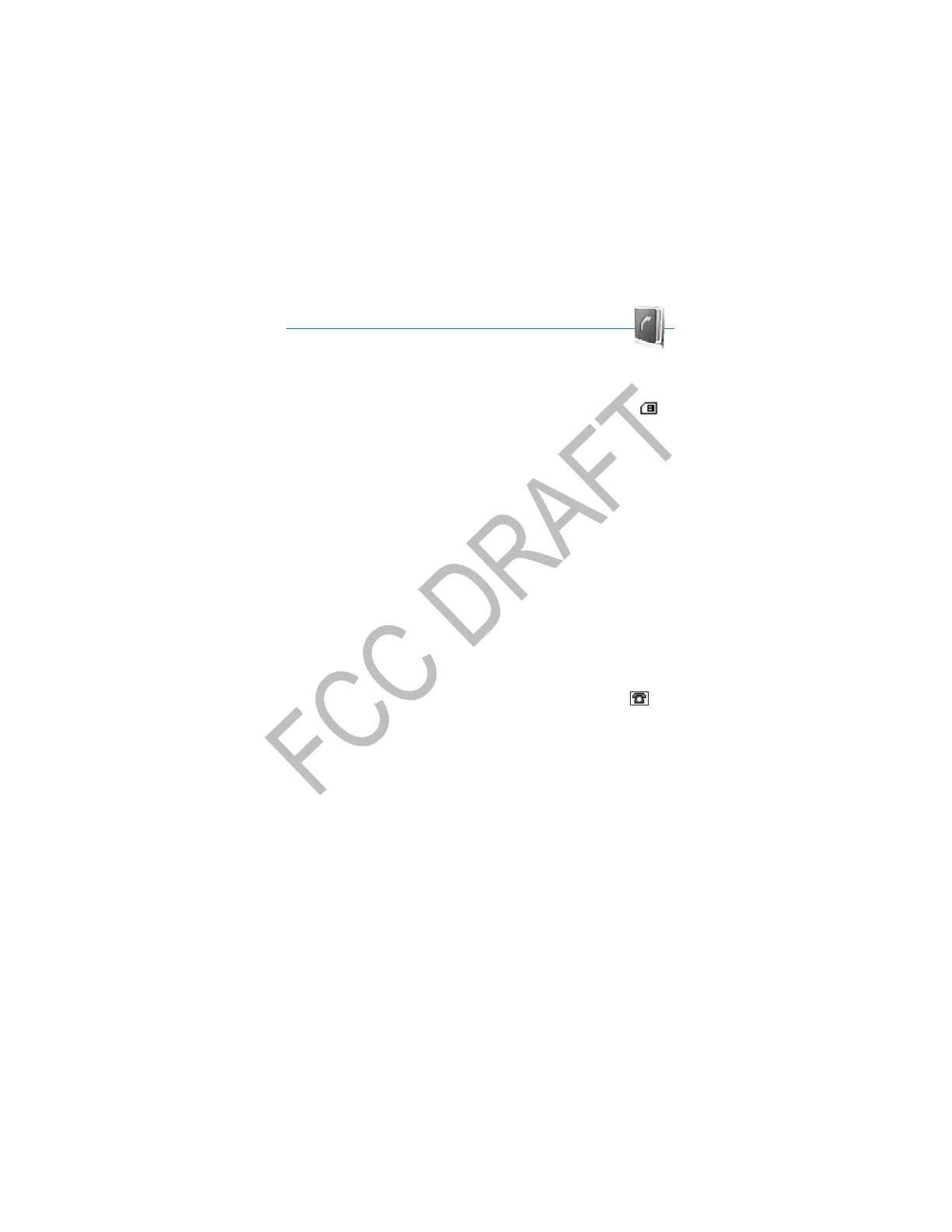
Contacts
45
6. Contacts
In Contacts, you can store and manage contact information, such as
names, phone numbers, and addresses. You can save names and numbers in the
internal memory of the phone, the SIM card memory, or in a combination of the
two. Names and numbers saved in the SIM card memory, are indicated by .
■Search
Select Menu > Contacts > Names and scroll through the list of contacts or enter
the first letter of the name you are trying to find.
■Save names and phone numbers
Names and numbers are saved in the used memory. Select Menu > Contacts >
Names > Options > Add new contact and enter the last name, first name, and
phone number.
■Save numbers, items, or an image
In the phone memory for contacts, you can save different types of phone
numbers and short text items per name. You can also assign a ringing tone to a
contact.
The first number you save is automatically set as the default number and it is
indicated with a frame around the number type indicator (for example, ).
When you select a name, the default number is used unless you select another
number.
1. Make sure that the memory in use is either Phone or Phone and SIM.
2. Scroll to the name to which you want to add a new number or text item, and
select Details > Options > Add detail.
3. To add a number, select Number and one of the number types.
4. To add another detail, select a text type, an image from the Gallery, or a new
image.
5. To change the number type, scroll to the number you want, and select
Options > Change type. To set the selected number as the default number,
select Set as default.

Contacts
46
6. Enter the number or text item; to save it, select Save.
7. To return to standby mode, select Back > Exit.
■Copy a contact
Find the contact you want to copy, and select Options > Copy contact. You can
copy names and phone numbers from the phone contact memory to the SIM card
memory or vice versa. The SIM card memory can save names with one phone
number attached to them.
■Edit contact details
1. Find the contact you want to edit, select Details; and scroll to the name,
number, text item, or image you want.
2. To edit a name, number, or text item, or to change image, select Options >
Edit.
You cannot edit an ID when it is on the IM contacts or the Subscribed names
list.
■Delete contacts or details
To delete all the contacts and the details attached to them from the phone or SIM
card memory, select Menu > Contacts > Delete all contacts > From phone mem.
or From SIM card. Confirm with the security code.
To delete a contact, find the contact you want, and select Options > Delete
contact.
To delete a number, text item, or an image attached to the contact, find the
contact, and select Details. Scroll to the desired detail, and select Options >
Delete > Delete number, Delete detail, or Delete image. Deleting an image from
contacts does not delete it from the Gallery.
■Business cards
You can send and receive a person’s contact information from a compatible
device that supports the vCard standard as a business card.
To send a business card, find the contact whose information you want to send,
and select Details > Options > Send bus. card >Via multimedia, Via text message,
or Via Bluetooth.

Contacts
47
When you have received a business card, select Show > Save to save the business
card in the phone memory. To discard the business card, select Exit > Yes.
■Settings
Select Menu > Contacts > Settings and one of the following options:
Memory in use — to select the SIM card or phone memory for your contacts.
Select Phone and SIM to recall names and number from both memories. In that
case, when you save names and numbers, they are saved in the phone memory.
Contacts view — to select how the names and numbers in Contacts are displayed.
Name display — to select whether the contact’s first or last name is displayed
first.
Font size — to set the font size for the list of contacts.
Memory status — to view the free and used memory capacity.
■Groups
Select Menu > Contacts > Groups to arrange the names and phone numbers
saved in the memory into caller groups with a different ringing tone and a group
image.
■1-touch dialing
To assign a number to a 1-touch-dialing key, select Menu > Contacts > 1-touch
dialing and scroll to the 1-touch-dialing number that you want.
Select Assign or, if a number has already been assigned to the key, select
Options > Change. Select Find and the contact you want to assign. If the
1-touch dialing function is off, the phone asks whether you want to activate it.
To make a call using 1-touch dialing, see “1-touch dialing,” p. 23.
■Service and my numbers
Select Menu > Contacts and one of the following options:
Service numbers — to call the service numbers of your service provider if the
numbers are included on your SIM card (network service)
My numbers — to view the phone numbers assigned to your SIM card. This is only
shown if the numbers are included on your SIM card.

Call log
48
7. Call log
The phone logs the phone numbers of identified missed, received,
and dialed calls, and the approximate length of your calls. The phone logs missed
and received calls only if the network supports these functions and the phone is
turned on and within the network’s service area.
To view the information on your calls, select Menu > Log > Missed calls,
Received calls, or Dialed numbers. To view your recent missed and received calls
and the dialed numbers chronologically, select Call log. To view the contacts to
whom you most recently sent messages, select Message recipients.
To view the approximate information on your recent communications, select
Menu > Log > Call timers, Packet data counter, or Packet data conn. timer.
To view how many text and multimedia messages you have sent and received,
select Menu > Log > Message log.
Note: The actual invoice for calls and services from your service
provider may vary, depending on network features, rounding off for
billing, taxes, and so on.
Some timers, including the life timer, may be reset during service or
software upgrades.
■Positioning information
The network may send you a location request. You can ensure that the network
will deliver location information of your phone only if you approve it (network
service). Contact your service provider to subscribe and to agree upon the
delivery of location information. Some networks allow you to request the
position of the phone (network service).
To accept or decline the location request, select Accept or Reject. If you miss the
request, the phone automatically accepts or declines it according to what you
have agreed with your service provider. The phone displays 1 missed position
request. To view the missed location request, select Show.
To view the information on the 10 most recent privacy notifications and requests
or to delete them, select Menu > Log > Positioning > Position log > Open folder
or Delete all.
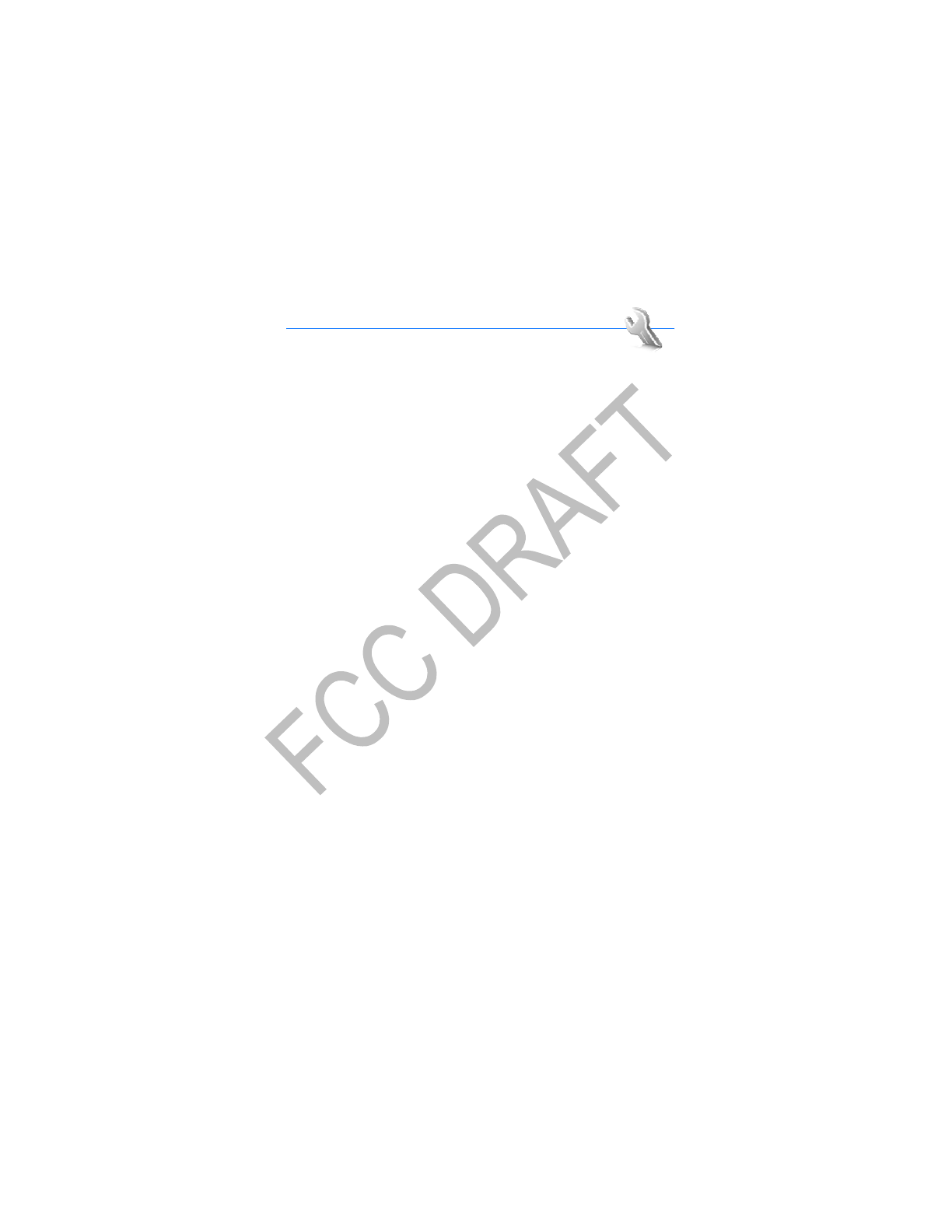
Settings
49
8. Settings
Use this menu to set or change your profiles, themes, personal
shortcuts, time and date settings, connectivity settings, call settings, phone
settings, main display settings, mini display settings, tone settings, enhancement
settings, configuration settings, security settings, and to restore factory settings.
■Profiles
Your phone has various setting groups, called profiles, for which you can
personalize the phone tones for different events and environments.
Select Menu > Settings > Profiles and a profile.
• To activate the selected profile, select Activate.
• To personalize the profile, select Customize, and select the setting you want
to change, then make the changes.
• To set the profile to be active until a certain time (up to 24 hours), select
Timed and set the time you want the profile setting to end. When the time set
for the profile expires, the previous profile (that was not timed) becomes
active.
■Themes
You can change the look of your phone display by activating a theme. A theme
can include a wallpaper image, a ringing tone, a screen saver, and a color scheme.
Themes are stored in the Gallery.
Select Menu > Settings > Themes and one of the following options:
Select theme — to set a theme in your phone. A list of folders in the Gallery opens.
Open the Themes folder, and select a theme.
Theme downloads — to open a list of links to download more themes. See
“Download settings,” p. 91.
■Tones
You can change the settings of the selected active profile.

Settings
50
Select Menu > Settings > Tones and edit the available settings. You can find the
same settings when you personalize a profile in the Profiles menu. See “Profiles,”
p. 49.
To set the phone to ring only upon calls from phone numbers that belong to a
selected caller group, select Alert for:. Scroll to the caller group you want or All
calls, and select Mark.
■Display
With display settings, you can personalize your display view of the phone.
Main display
You can select display settings for the start screen (main display).
Standby mode settings
Select Menu > Settings > Main display and one of the following options:
Wallpaper — to display a background picture (wallpaper) on the start screen.
Select Wallpapers and from the following:
•Image or
•Slide set and an image or a slide from the Gallery or
•Open Camera.
Select Graphic downloads to download more graphics.
Active standby — to display the active standby. Select one of the following
options:
•Personalize view — to change the content and to reorganize the content on
the display Options > Move content.
•Active standby key — to change the key for accessing the navigation mode.
The same setting is also in the My shortcuts menu. See “Enabling active
standby,” p. 53.
Standby mode font color — to select the color for the texts on the display in the
standby mode
Navigation key icons — to set the scroll key icons that are shown in the standby
mode

Settings
51
Fold animation — to select whether an animation is shown when you open and
close the fold. The fold animation is only visible if it is supported by and selected
from the active theme set in your phone. See “Themes,” on p. 49.
Operator logo — to set your phone to display or hide the operator logo.
Cell info display > On — to receive information from the network operator
depending on the network cell used (network service).
Screen saver
To select a screen saver, select Menu > Settings > Main display > Screen saver >
Screen savers > Image, Slide set, Video clip, Open Camera, Analog clock, or Digital
clock. To download more screen savers, select Graphic downloads. To enter the
time after which the screen saver is activated, select Time-out. To activate the
screen saver, select On.
Font size
This feature allows you to select the font size for Messaging, Contacts, and Web.
Select Menu > Settings > Main display > Font size and one of the following:
Messaging — to select the font size you want to use for messages. Select Extra
small font, Normal font, or Large font.
Contacts — to select the font size you want to display your contacts’ names.
Select Normal font or Large font.
Web — to select the font size you want to display for mobile internet pages.
Select Extra small font, Small font, or Normal font.
Mini display
You can select display settings for the mini display on the front of your phone.
Screen saver
Select Menu > Settings > Mini display > Screen saver > Analog clock or Digital
clock. To enter the time after which the screen saver is activated, select Time-out.
To activate the screen saver, select On.
■Time and date
Select Menu > Settings > Time and date and one of the following options:
Time — to set the phone to show or hide the clock in the standby mode, adjust the
time, and select the time zone and the time format

Settings
52
Date — to set the phone to show or hide the date in the standby mode, set the
date, and select the date format and date separator
Auto-update of date & time (network service) — to set the phone to
automatically update the time and date to the appropriate time zone.
■My shortcuts
You can set your most frequently used functions to be quickly accessed through
the My shortcuts feature.
Left selection key
To select a function from the list for the left selection key, select Menu >
Settings > My shortcuts > Left selection key. See also “Standby mode,” p. 18.
To activate a function in the standby mode if the left selection key is Go to, select
Go to and the function you want on your personal shortcut list.
Select Options and from the following options:
Select options — to add a function to the shortcut list or to remove one. Scroll to
the function, and select Mark or Unmark.
Organize — to rearrange the functions on your personal shortcut list. Scroll to the
function you want to move, and select Move. Scroll to where you want to move
the function, and select OK. Repeat this process, if you want to move another
function. When you have completed rearranging the functions you want, select
Done > Yes.
Right selection key
To set a specific function (from a predefined list) to the right selection key, select
Menu > Settings > My shortcuts > Right selection key. This function can be used
only if it is supported by your service provider.
Navigation key
This key allows you to scroll up, down, left, and right. To assign other phone
functions (from a predefined list) to the navigation key, select Menu > Settings >
My shortcuts > Navigation key. Scroll to the key you want, select Change and a
function from the list. To remove a shortcut function from the key, select (empty).
To reassign a function for the key, select Assign.

Settings
53
Enabling active standby
This function allows you to select how the active standby mode is activated.
Select Menu > Settings > My shortcuts > Active standby key > Navigation key
up, Navigat. key down, or Nav. key up/down.
Voice commands
You can call contacts and carry out phone functions by saying voice commands.
Voice commands are language-dependent. To set the language, see Voice
recognition language in “Phone,” p. 62.
To select the phone functions to activate with a voice command, select Menu >
Settings > My shortcuts > Voice commands and a folder. Scroll to a function you
want. indicates that the voice tag is activated. To deactivate the voice
command, select Options > Remove. To activate the voice tag, select Add. To
play the activated voice command, select Playback. To use voice commands, see
“Enhanced voice dialing,” p. 23.
To manage the voice commands, scroll to a phone function, and select from the
following options:
Edit or Remove — to change or deactivate the voice command of the selected
function
Remove all — to deactivate voice commands to all functions in the voice
commands list.
■Connectivity
You can connect the phone to compatible devices, using Bluetooth wireless
technology or USB data cable (CA-53) connection. You can also define the
settings for EGPRS or GPRS dial-up connections.
WLAN/Wi-Fi
Important: Always enable one of the available encryption methods to
increase the security of your wireless LAN connection. Using encryption
reduces the risk of unauthorized access to your data.
Note: Some places, like France, have restrictions on the use of wireless
LAN. Check with your local authorities for more information.
Your device supports voice calls over the internet (internet calls) and attempts
emergency calls primarily over cellular networks. If an emergency call using
cellular networks is not successful, your device attempts an emergency call

Settings
54
through your net call provider. Due to the established nature of cellular
telephony, you should use cellular networks for emergency calls, if possible. If
you have cellular network coverage available, make sure that your cellular phone
is switched on and ready to make calls before you attempt an emergency call. The
capability for an emergency call using internet telephony depends on the
availability of a wireless local area network (WLAN) and your net call provider's
implementation of emergency call capabilities. Contact your net call provider to
check the internet telephony emergency call capability.
This device can detect and connect to a WLAN through call over local access. This
unlicensed mobile access (UMA) technology allows a seamless handoff of mobile
voice and data from a wide area cellular network to WLAN or wireless fidelity
(Wi-Fi), so it is possible to connect at a high speed to the internet from virtually
anywhere.
Before you can start using UMA, you must first obtain a UMA account with your
service provider. The proper settings may already be configured in your phone
because this device was specially designed to detect and connect to WLAN/Wi-Fi.
For more information, contact your service provider.
If you move the device to another location within the wireless LAN and out of
range of a WLAN/Wi-Fi access point, the roaming function can automatically
connect your device to another access point that belongs to the same network.
As long as you remain within range of access points that belong to the same
network, your device can stay connected to the network.
A WLAN/Wi-Fi connection is established when you create a data connection
using a WLAN/Wi-Fi access point. The active WLAN/Wi-Fi connection is ended
when you end the data connection.
Features using WLAN/Wi-Fi, or allowing such features to run in the background
while using other features, increase the demand on battery power and reduce the
battery life.
Tutorial
To see the tutorial at any time, select Menu > Applications > Collection >
Tutorial. To exit the tutorial at any time, select Exit.
Turn on WLAN/Wi-Fi
Select Menu > Settings > Connectivity > Wi-Fi >Wi-Fi radio > On.
Quick connection
Quick connection allows you to connect to an open network with the best signal
strength.

Settings
55
1. From the standby mode, select Go to > Quick connect or, from the Wi-Fi
menu, select Quick connect.
2. If you have not connected to WLAN/Wi-Fi first, a message asks if you want to
turn on WLAN/Wi-Fi first. Select Yes.
3. If you are already connected to another network, a message asks if you want
to disconnect from that network. Select Yes.
The phone searches for networks and when the network with the best signal
strength is found, a message is displayed, which confirms the network
connection. If you have not saved the network, a message asks if you want to
save it. Select Yes or No if you want to save the network or not. If no available
networks can be found, No quick connect networks available is displayed.
Available networks
The list of available networks displays all the available networks to which you can
connect. indicates that a network is connected and indicates that a
network is saved.
A network may be hidden and can only be found by searching for its service set
identifier (SSID). An SSID is a code attached to all packets on a wireless network
in order to identify each packet as part of that network. All wireless devices
attempting to communicate with each other must share the same SSID.
1. Select Menu > Settings > Connectivity > Wi-Fi >Available networks.
2. If you have not already connected to WLAN/Wi-Fi, a message asks if you want
to turn on WLAN/Wi-Fi. Select Yes.
The phone searches for available networks and, when the networks are found,
they are listed in signal strength order.
3. Scroll to the network you want, and select Connect.
A message is displayed, which confirms the network connection. If you have
not saved the network, a message asks if you want to save it.
4. Select Yes or No to indicate whether to save the network.
5. To save an available network to which you have not connected, select
Options > Save.
6. To update the list of available networks, select Options > Refresh. If the list of
available networks is empty, select Refresh.

Settings
56
7. To locate a hidden network, select Options > Hidden networks, enter the SSID
of the network you want to find, and select OK.
8. To disconnect from the network, select Disconn.
Saved networks
The list of saved networks consists of all the networks you have saved on your
phone. The name of the network and the connection setting is displayed. The
networks are listed in order of priority and the network with the highest priority
is automatically the first one where a connection attempt is made.
1. Select Menu > Settings > Connectivity > Wi-Fi > Saved networks.
2. Scroll to the network you want, and select Connect.
3. If you have not already connected to WLAN/Wi-Fi, a message asks if you want
to turn on WLAN/Wi-Fi. Select Yes.
A message is displayed, which confirms the network connection.
4. To rename a saved network, scroll to the network you want, and select
Options > Rename. Select Clear as many times as necessary to delete the
network name, enter the new network name, and select OK.
5. To forward the settings of a saved network, scroll to the network you want,
select Options > Forward settings, enter the security code (the preset code is
12345), and select OK. Enter a phone number, and select Send.
6. To change the priority of a saved network, select Options > Organize priority,
scroll to the network you want, and select Move > Move up, Move down,
Move to top, or Move to bottom > Done > Yes.
Each saved network has its individual connection settings, which offer different
ways to connect to the network. Scroll to the network you want, select Options >
Conn. setting, and one of the following options:
Ask first — to be asked to be connected to a network when it becomes available
Automatic — to be connected to the network automatically
Manual — to be connected to the network only when done manually.
Other options for saved networks are: edit a saved network’s settings, delete a
saved network, or add a new network.

Settings
57
Add to saved networks
You can also add a network to the saved networks list from the Wi-Fi menu. You
can either manually enter a network, for which you must have a valid SSID, or
select from the available networks.
To save from available networks, do the following:
1. To save a network from the available networks, select Available networks.
2. If you have not already connected to WLAN/Wi-Fi, a message asks if you want
to turn on WLAN/Wi-Fi. Select Yes.
The phone searches for available networks and when the networks are found,
they are listed in signal strength order.
3. Scroll to the network you want, and select Options > Save.
4. Select Clear as many times as necessary to delete the network name and
enter the new network name.
5. Select OK.
Turn off WLAN/Wi-Fi while connected
Select Menu > Settings > Connectivity > Wi-Fi > Wi-Fi radio > Off > Yes.
Wi-Fi call settings
Configuration — to select which UMA configuration to use
Account — to select which UMA account to use.
Connection failure
You may not be able to connect to the network at times. Try connecting to the
network later because this may only be a temporary error. If the connection still
fails, contact your service provider.
Login failure
If you attempt to login to a network without a UMA subscription, the message
Contact your service provider is displayed.
Bluetooth wireless technology
This device is compliant with Bluetooth Specification 2.0 supporting the
following profiles: hands-free, headset, network access, object push profile, file
transfer profile, dial-up networking profile, SIM access profile, serial port profile,
service discovery application profile, personal area network profile, advanced
audio distribution profile, and audio video remote control profile. To ensure

Settings
58
interoperability between other devices supporting Bluetooth technology, use
Nokia approved enhancements for this model. Check with the manufacturers of
other devices to determine their compatibility with this device.
There may be restrictions on using Bluetooth technology in some locations.
Check with your local authorities or service provider.
Features that use Bluetooth technology, or allow such features to run in the
background while using other features, increase the demand on battery power
and reduce the battery life.
Bluetooth technology allows you to connect the phone to a compatible
Bluetooth device within 10 meters (33 feet). Because devices using Bluetooth
technology communicate using radio waves, your phone and the other devices do
not need to be in direct line-of-sight, although the connection can be subject to
interference from obstructions, such as walls or from other electronic devices.
To set up a Bluetooth connection, do the following:
1. Select Menu > Settings > Connectivity > Bluetooth.
2. To activate or deactivate the Bluetooth function, select Bluetooth > On or
Off. indicates an active Bluetooth connection.
3. To find compatible Bluetooth audio devices, select Search for audio
enhancements and the device that you want to connect to the phone.
To find any Bluetooth device in range, select Paired devices. Select New to list
any Bluetooth device in range. Scroll to a device, and select Pair.
4. Enter the Bluetooth passcode of the device to associate (pair) the device to
your phone. You must only give this passcode when you connect to the device
for the first time. Your phone connects to the device and you can start data
transfer.
Settings
To define how your phone is shown to other Bluetooth devices, select Menu >
Settings > Connectivity > Bluetooth > My phone's visibility or My phone's name.
Operating the phone in hidden mode is a safer way to avoid malicious software.
Do not accept Bluetooth connectivity from sources you do not trust.
Another alternative is to turn off the Bluetooth functionality. This does not affect
other functions of the phone.

Settings
59
Connection
Select Menu > Settings > Connectivity > Bluetooth. To check which Bluetooth
connection is currently active, select Active devices. To view a list of Bluetooth
devices that are currently paired with the phone, select Paired devices.
Select Options to access available options, depending on the status of the device
and the Bluetooth connection.
Packet data
General packet radio service (GPRS) is a network service that allows mobile
phones to send and receive data over an internet protocol (IP)-based network.
GPRS is a data bearer that enables wireless access to data networks such as the
internet.
Enhanced GPRS (EGPRS) is similar to GPRS, but enables faster connections. For
more information on availability of EGPRS or GPRS and data transfer speed,
contact your network operator or service provider.
The applications that may use EGPRS or GPRS are MMS, video streaming,
browsing sessions, e-mail, remote SyncML, Java application downloading, and
the PC dial-up.
When you have selected GPRS as a data bearer, the phone uses EGPRS instead of
GPRS, if this is available in the network. You cannot select between EGPRS and
GPRS, but for some applications you may be able to select GPRS or GSM data
(circuit-switched data, CSD).
To define how to use the service, select Menu > Settings > Connectivity > Packet
data > Packet data connection and one of the following options:
When needed — to set the packet data registration and connection to established
when an application using packet data needs it and closed when you end the
application
Always online — to set the phone to automatically register to an packet data
network when you switch the phone on. or indicates that the GPRS or
EGPRS service is available.
If you receive a call or a text message, or make a call during a GPRS or EGPRS
connection, or indicates that the GPRS or EGPRS connection is suspended
(on hold).

Settings
60
Packet data settings
You can connect the phone using Bluetooth wireless technology or USB data
cable connection to a compatible PC and use the phone as a modem to enable
EGPRS or GPRS connectivity from the PC.
To define the settings for EGPRS or GPRS connections from your PC, select
Menu > Settings > Connectivity > Packet data > Packet data settings > Active
access point and activate the access point you want to use. Select Edit active
access point > Alias for access point, enter a name to change the access point
settings, and select OK. Select Packet data access point, enter the access point
name (APN) to establish a connection to an EGPRS or GPRS network, and select
OK.
You can also set the EGPRS or GPRS dial-up service settings (access point name)
on your PC, by using the One Touch Access software. See “Nokia PC Suite,” p. 96.
If you have set the settings both on your PC and on your phone, the PC settings
are used.
Data transfer and synchronization
Synchronize your data from calendar, notes, and contacts with another
compatible device (for example, a mobile phone), a compatible PC, or a remote
internet server (network service).
Your phone allows data transfer with a compatible PC or another compatible
device when using the phone without a SIM card. When you use the phone
without a SIM card, some functions appear dimmed in the menus and cannot be
used. To synchronize with a remote internet server is not possible without a SIM
card.
To copy or synchronize data from your phone, the name of the device and the
settings must be in the list of partners in transfer contacts. If you receive data
from another compatible device, the partner is automatically added to the list,
using the contact data from the other device. Server sync and PC sync settings are
the original items in the list.
To add a new partner to the list, such as a new device, select Menu > Settings >
Connectivity > Data transfer > Options > Add contact > Phone sync or Phone
copy and enter the settings according to the transfer type.
To edit the copy and synchronize settings, select a contact from the partner list,
and select Options > Edit.
To delete a selected partner, select Options > Delete> OK. You cannot delete
Server sync and Phone sync.

Settings
61
Data transfer with a compatible device
For synchronization, Bluetooth wireless technology is used. The other device is in
the standby mode.
To start a data transfer, select Menu > Settings > Connectivity > Data transfer
and the transfer partner from the list other than Server sync and PC sync. Based
on the settings, the selected data is copied or synchronized. The other device also
must be activated to receive data.
Synchronize from a compatible PC
To synchronize data from calendar, notes, and contacts from a compatible PC,
use Bluetooth wireless technology or a USB data cable (CA-53). You also need
the correct version of Nokia PC Suite software for your phone installed on the PC.
See “Computer connectivity,” p. 96 for information about Nokia PC Suite.
Synchronize the data in the phone contacts, calendar, and notes to correspond
with the data of your compatible PC by starting the synchronization from the PC.
Synchronize from a server
To use a remote internet server, you have to subscribe to a synchronization
service. For more information and the settings required for this service, contact
your service provider. You may receive the settings as a configuration message.
See “Configuration settings service,” p. 10 and “Configuration,” p. 64.
If you have saved data on the remote internet server, you can synchronize your
phone by starting the synchronization from your phone.
Select Menu > Settings > Connectivity > Data transfer > Server sync >
Initializing sync or Initializing copy.
If the contacts or calendar are full, synchronizing may take up to 30 minutes to
complete when synchronizing for the first time or after an interrupted
synchronization.
USB data cable
You can use the USB data cable to transfer data between the memory card
inserted in the phone and a compatible PC or a printer supporting PictBridge. You
can also use the USB data cable with Nokia PC Suite.
To activate the memory card for data transfer or picture printing, connect the
data cable; when the phone displays USB data cable connected. Select mode.,
select OK and one of the following options:
Nokia mode — to use the cable for Nokia PC Suite

Settings
62
Printing & media — to print pictures directly from the phone by using a
compatible printer
Data storage — to activate the memory card for data transfer
To change the USB mode, select Menu > Settings > Connectivity > USB data
cable > Nokia mode, Printing, or Data storage.
■Call
Select Menu > Settings > Call and one of following options:
Call forwarding — to forward your incoming calls (network service). Call
forwarding and call restrictions cannot be active at the same time. See Call
restrictions in “Security,” p. 65.
Anykey answer > On — to answer an incoming call by briefly pressing any key,
except the left and right selection keys, volume key, camera key, or the end key.
Answer when fold is opened > On — to set your phone to answer a call when you
open the fold. If the setting is off, you must press the call key after you open the
fold.
Automatic redial > On — to set your phone to make a maximum of 10 attempts to
connect the call after an unsuccessful call attempt.
1-touch dialing > On — to dial the names and phone numbers assigned to the
1-touch dialing keys, 2 to 9. To dial, press and hold the corresponding number
key.
Call waiting > Activate — to set the network to notify you of an incoming call
while you have a call in progress (network service). See “Call waiting,” p. 24.
Summary after call > On — to briefly display the approximate duration of the call
after each call
Send my caller ID > Yes — to show your phone number to the person you are
calling (network service). To use the setting agreed upon with your service
provider, select Set by network.
■Phone
Select Menu > Settings > Phone and one of the following options:
Language settings > Phone language — to set the display language of your
phone. If you select Automatic, the phone selects the language according to the
information on the SIM card.
• To select the USIM card language, select SIM language.

Settings
63
• To set a language for the voice playback, select Voice recognition language.
See “Make a voice dialing call,” p. 23 and Voice commands in “My shortcuts,”
p. 52.
Memory status — to view the free memory and the used memory for each
function in the list.
Automatic keyguard — to set the keys to lock automatically. Choose On and the
time-out to activate the keyguard or Off to set the automatic keyguard off.
Security keyguard — to set the phone to ask for the security code when you
unlock the keyguard. Enter the security code, and select On. When the keyguard
is on, calls still may be possible to the official emergency number programmed
into your device.
Flight query — to set the phone to ask if Flight mode should be used each time the
phone is turned on. In Flight mode, all radio connections are turned off. Flight
mode should be used in areas sensitive to radio emissions.
Welcome note — to create the welcome note you would like to be shown briefly
when the phone is turned on.
Phone updates — to view the current phone software version, to download new
phone software and, to install downloaded phone software. See “Phone software
updates,” p. 66.
Operator selection > Automatic — to set the phone automatically to select one of
the cellular networks available in your area. With Manual, you can select a
network that has a roaming agreement with your service provider.
Confirm SIM service actions. This option is shown only if supported by your SIM
card. See “SIM services,” p. 95.
Help text activation — to select whether the phone displays help texts.
Start-up tone — to select whether the phone plays a start-up tone when the
phone is turned on.
Switch off tone — to select whether the phone plays a switch off tone when the
phone is turned off. This menu is only visible if the tone exists in Themes or is part
of the power-down functionality of your service provider.
Fold close handling — to select whether closing the fold causes the phone to go
to standby mode or to keep all running applications open.

Settings
64
■Enhancements
This menu is shown only if the phone is or has been connected to a compatible
mobile enhancement, other than the charger.
Select Menu > Settings > Enhance-ments. You can select an enhancement menu
if the corresponding enhancement is or has been connected to the phone.
Depending on the enhancement, select from one of the following options:
Default profile — to select the profile that you want to be automatically activated
when you connect to the selected enhancement.
Automatic answer — to set the phone to answer an incoming call automatically
after five seconds. If Incoming call alert is set to Beep once or Off, automatic
answer is off.
Lights — to set the lights permanently On. Select Automatic to set the lights on
for 15 seconds after a keypress.
Ignition detector > On — to automatically switch off the phone approximately 20
seconds after you switch off the car ignition, when the phone is connected to the
full car kit.
TTY/TDD > Use TTY > Yes — to use text phone settings instead of headset settings.
■Configuration
You can configure your phone with settings that are required for certain services
to function correctly. The services are multimedia messaging, instant messaging,
synchronization, e-mail application, streaming, push to talk, and browser. Your
service provider may also send you these settings as a configuration message.
To save the configuration settings received as a configuration message, see
“Configuration settings service,” p. 10.
Select Menu > Settings > Configura-tion and one of the following options:
Default configu- ration settings — to view the service providers saved in the
phone. Scroll to a service provider, and select Details to view the applications
that the configuration settings of this service provider supports. To set the
configuration settings of the service provider as default settings, select
Options > Set as default. To delete configuration settings, select Delete.
Activate default in all applications — to activate the default configuration
settings for supported applications.

Settings
65
Preferred access point — to view the saved access points. Scroll to an access
point, and select Options > Details to view the name of the service provider, data
bearer, and packet data access point or GSM dial-up number.
Connect to service provider support — to download the configuration settings
from your service provider, if this is supported by your service provider
Personal configu- ration settings — to add new personal accounts for various
services manually and to activate or delete them. To add a new personal account,
if you have not added any, select Add new. Otherwise, select Options > Add new.
Select the service type and enter each of the required parameters. The
parameters differ according to the selected service type. To delete or activate a
personal account, scroll to it, and select Options > Delete or Activate.
■Security
When security features that restrict calls are in use (such as, call restricting,
closed user group, and fixed dialing) calls still may be possible to the official
emergency number programmed into your device.
Select Menu > Settings > Security and one of the following options:
PIN code request — to set the phone to ask for your PIN or UPIN code every time
the phone is switched on. Some SIM cards do not allow the code request to be
turned off.
Call restrictions — to restrict incoming calls to and outgoing calls from your
phone (network service). A password is required.
Fixed dialing — to restrict your outgoing calls to selected phone numbers, if this
function is supported by your SIM card.
Closed user group — to specify a group of people whom you can call and who can
call you (network service).
Security level > Phone — the phone asks for the security code whenever a new
SIM card is inserted into the phone. Select Memory and the phone asks for the
security code when the SIM card’s memory is selected and you want to change
the memory in use.
Access codes — to set the PIN code or UPIN code in use or to change the security
code, PIN code, UPIN code, PIN2 code, and call restrictions password.
Code in use — to select whether the PIN code or UPIN code should be active
Authority certificates or User certificates — to view the list of the authority or
user certificates downloaded into your phone. See “Certificates,” p. 93.

Settings
66
Security module settings — to view Security module details, activate Module PIN
request, or change the module PIN and signing PIN. See also “Access codes,” p. 9.
■Restore factory settings
To reset some of the menu settings to their original values, select Menu >
Settings > Restore settings and enter the security code. Data that you have
entered or downloaded is not deleted. For example, names and numbers in
Contacts are not affected.
■Phone software updates
You may initiate phone software updates from the Phone updates menu. Also,
your service provider may initiate the updates by sending them over the air
directly to your device. This function is known as firmware over the air (FOTA).
Warning: If you install a software update, you cannot use the device,
even to make emergency calls, until the update is completed and the
device is restarted. Be sure to back up data before accepting a FOTA
update.
Download
Select Menu > Settings > Phone > Phone updates to request available phone
software updates from your service provider. Select Current software details to
display the current software version. Select Download phone software to
download and install a phone software update (if an update is available). Follow
the instructions on the display.
Important: Only install and use applications and other software from
sources that offer adequate security and protection against harmful
software.
Install
Select Install software update to start the installation, if you cancelled the
installation after the download.
The software update may take several minutes.
Note: If there are problems with the download or installation, contact
your service provider.

Operator menu
67
9. Operator menu
Your service provider may have programmed an operator-specific menu into your
phone. If this menu exists in your phone, its functions depend entirely upon the
service provider. Contact your service provider for more information.
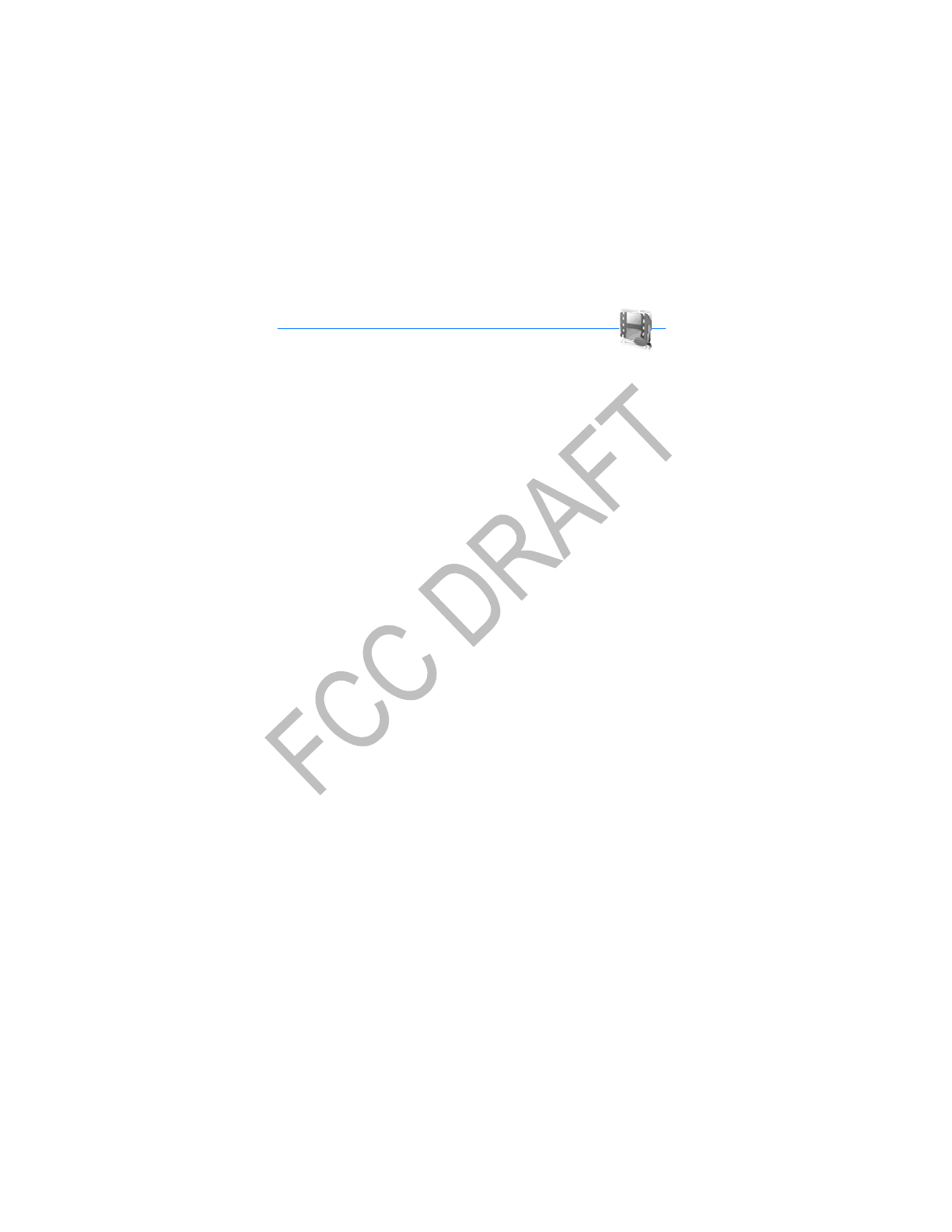
Gallery
68
10. Gallery
In this menu, you can manage graphics, images, recordings, and
tones. These files are arranged in folders.
Your phone supports an activation key system to protect acquired content.
Always check the delivery terms of any content and activation key before
acquiring them, as they may be subject to a fee.
The files stored in the Gallery use the memory capacity of the phone. You can use
a compatible memory card to extend the memory capacity to store images,
themes, graphics, ringing tones, video clips, and sound clips in the Gallery.
To manage the files and folders, do the following:
1. Select Menu > Gallery. A list of folders is shown. If a memory card is inserted
in the phone, the folder Memory card, (unformat.), or the name of the
memory card is shown.
2. Scroll to the folder you want. To view a list of files in the folder, select Open.
For the available options, select Options.
3. Scroll to the file you want to view, and select Open. For the available options,
select Options.
■Format memory card
To format a new memory card, select Menu > Gallery. Scroll to the memory card
folder, and select Options > Format mem. card.

Media
69
11. Media
■Camera
You can take photos or record video clips with the built-in camera. The camera
lens is on the front of the phone. The color display works as a viewfinder.
Take a photo
1. Select Menu > Media > Camera > Capture or press the camera key, and
select Capture.
The phone saves the photo in Gallery > Images unless you set the phone to
use the memory card to save photos.
2. To take another photo, select Back.
3. To zoom in or out, press the four-way navigation key up or down.
4. To take up to five photos in quick succession, select Options > Img. sequence
on > Sequen. To take another photo, select Options > New image.
The higher the resolution, the fewer photos you can take sequentially.
5. To send the photo as a multimedia message, select Send.
6. To set a timer to delay capturing a photo for 10 seconds, select Options >
Self-timer on > Start.
A beep sounds while the self-timer is running. It beeps faster when the
camera is about to capture the photo. After the timeout, the camera takes the
photo and saves the photo in Gallery > Images.
To take a photo when the lighting is dim, the camera automatically adjusts a
longer exposure time so the photo quality is better.
This Nokia device supports an image capture resolution up to 640x480 pixels. The
image resolution in these materials may appear different.
Record a video clip
Select Menu > Media > Camera > Options > Video > Record. To pause
recording, select Pause; to resume recording, select Continue. To stop recording,
select Stop. The phone saves the recording in Gallery > Video clips. To view the
options, select Options.

Media
70
Camera settings
Select Menu > Media > Camera > Options > Settings and edit the available
settings.
Camera effects
Select Menu > Media > Camera > Options > Effects and one of the available
options.
■Media player
With the media player you can view, play, and download files, such as images,
audio, video and animated images. You can also view compatible streaming
videos from a network server (network service).
Select Menu > Media > Media player > Open gallery, Bookmarks, Go to address,
or Media downloads.
Set for streaming service
You may receive the configuration settings required for the streaming as a
configuration message from the network operator or service provider. See
“Configuration settings service,” p. 10. To enter the settings manually, see
“Configuration,” p. 64.
Select Menu > Media > Media player > Streaming sett. and one of the following
options:
Configuration — Only the configurations that support streaming are displayed.
Select a service provider, Default, or Personal config.
Account — Select a streaming service account contained in the active
configuration settings.
■Music player
Your phone includes a music player for listening to music tracks, recordings, or
MP3, MP4, WMA (Windows Media Audio), AAC, AAC+, or eAAC+ sound files that
you have transferred to the phone with the Nokia Music Manager application.
Music files are automatically detected and added to the default track list.

Media
71
Play music tracks
1. Select Menu > Media > Music player. The details of the first track on the
default track list are shown.
2. To play a track, scroll to the track, and select .
3. To skip to the beginning of the next track, select . To skip to the beginning
of the previous track, select twice.
4. To rewind the current track, select and hold . To fast forward the current
track, select and hold . Release the key at the position you want.
5. To pause the playing, select .
Warning: Listen to music at a moderate level. Continuous exposure to
high volume may damage your hearing.
Settings
In the Music player menu, the following options may be available:
Show tracks — to view all the tracks available on the track list. To play a track,
scroll to the track you want, and select Play.
Music library — to browse your music library according to following criteria: All
tracks, Artists, Albums, Genres, Composers or Track lists. To update the contents
of your music library, select Update library.
Play options > Random > On — to play the tracks in the track list in random
order. Select Repeat > Current track or All tracks to play the current track or the
entire track list repeatedly.
Media equalizer — to open the list of media equalizer sets. See “Equalizer,” p. 74.
Add to Favorites — to add the current song to the Favorites track list.
Play via Bluetooth — to connect and play music through a bluetooth-enabled
audio accessory using bluetooth connection.
Use tone — to use the current song as a ring tone for example. You are presented
a list of possible options for the tone.
Send — to send the selected file using MMS or a bluetooth connection.
Web page — to connect to a browser service related to the current track. This
function is only available when the address of the service is included in the track.
Music downloads — to download music through web.
Memory status — to view the free and used memory capacity.

Media
72
■Radio
The FM radio depends on an antenna other than the wireless device antenna. A
compatible headset or enhancement needs to be attached to the device for the
FM radio to function properly.
Warning: Listen to music at a moderate level.Continuous exposure to
high volume may damage your hearing.
Select Menu > Media > Radio. To use the graphical keys , , , or on
the phone display, scroll left or right to the key you want, and select it.
Save channels
1. To start the channel search, select and hold or . To change the radio
frequency in 0.05 MHz steps, press or .
2. To save the channel to a memory location 1 to 9, press and hold the
corresponding number key.
3. To save the channel in the memory location from 10 to 20, press 1 or 2, and
press and hold the number key (0 to 9) you want.
4. Enter the name of the channel, and select OK.
Listen
1. Select Menu > Media > Radio.
2. To scroll to the channel you want, select , , or press the headset key.
3. To select a radio channel location, briefly press the corresponding number
keys.
4. Select Options and one of the following options:
Turn off — to turn off the radio
Save station — to save a new channel by entering the channel’s name
Visual Radio — to set whether the Visual Radio application is used (network
service). To check the availability and costs, contact your network operator or
service provider. Some radio channels may send text or graphical information
that you can view using the Visual Radio application.

Media
73
Loudspeaker or Headset — to listen to the radio using the loudspeaker
(limited to FM radio) or headset. Keep the headset connected to the phone.
The lead of the headset functions as the radio antenna.
Mono output or Stereo output — to listen to the radio in monophonic sound
or in stereo
Stations — to select the list of saved channels. To delete or rename a channel
or edit the visual service ID, scroll to the channel you want, and select
Options > Delete station or Rename or Visual service ID.
Search all stations — to start automatic search and save function for all
available radio channels. The search picks up only the strongest available
radio channels.
Set frequency — to enter the frequency of the radio channel you want.
Station directory— to activate the station directory (network service) to seek
available radio stations and save them for later use.
Enable visual serv. — to set whether the Visual Radio application starts
automatically when you turn on the radio, select Enable visual serv. >
Automatically.
You can normally make a call or answer an incoming call while listening to the
radio. During the call, the volume of the radio is muted.
When an application using a packet data or HSCSD connection is sending or
receiving data, it may interfere with the radio.
■Recorder
You can record pieces of speech, sound, or an active call. This is useful when
recording a name and phone number for writing them down later.
Record sound
1. Select Menu > Media > Recorder.
2. To start recording, select . To start recording during a call, select Options >
Record. While recording a call, all parties to the call hear a faint beeping
sound. When recording a call, hold the phone in the normal position near to
your ear.
3. To stop recording, select .

Media
74
The recording is saved in Gallery > Recordings.
4. To listen to the latest recording, select Options > Play last recorded.
5. To send the last recording using bluetooth or as a multimedia message, select
Options > Send last recorded.
List of recordings
1. Select Menu > Media > Recorder > Options > Recordings list.
The list of folders in the Gallery is shown.
2. Open Recordings to see the list with recordings.
3. Select Options to select options for files in the Gallery. See “Gallery,” p. 68.
Define a storage folder
To use a folder other than Recordings as the default folder in the Gallery, select
Menu > Media > Recorder > Options > Select memory and a folder from the list.
■Equalizer
You can control the sound quality when using the music player by amplifying or
attenuating frequency bands.
1. Select Menu > Media > Equalizer.
2. To activate a set, scroll to one of the equalizer sets, and select Activate.
3. To view, edit, or rename a selected set, select Options > View, Edit, or
Rename.
Not all sets can be edited or renamed.
■Stereo widening
This function can only be used if your Nokia mobile phone is connected to a
compatible stereo headset.
To enhance the sound that is available in stereo with a wider stereo effect, select
Menu > Media > Stereo widening > On.

Push to talk
75
12. Push to talk
Push to talk (PTT) over cellular is a two-way radio service
available over a GSM/GPRS cellular network (network service). PTT provides
direct voice communication. To connect, press the volume up key.
You can use PTT to have a conversation with one person or with a group of people
having compatible devices. When your call is connected, the people you are
calling do not have to answer the phone. The participants should confirm the
reception of any communication where appropriate, as there is no other
confirmation whether the recipients have heard the call.
To check availability and costs, and to subscribe to the service, contact your
service provider. Roaming services may be more limited than for normal calls.
Before you can use the PTT service, you must define the required PTT service
settings. See “PTT settings,” p. 79.
While you are connected to the PTT service, you can use the other functions of
the phone. The PTT service is not connected to traditional voice communication;
therefore many of the services available for traditional voice calls (for example,
voice mailbox) are not available for PTT communication.
■Connect and disconnect
To connect to the PTT service, select Menu > Push to talk > Switch PTT on.
indicates the PTT connection. indicates that the service is temporarily
unavailable. The phone automatically tries to reconnect to the service until you
disconnect from the PTT service. If you have added channels to the phone, you are
automatically joined to the active channels.
To disconnect from the PTT service, select Switch PTT off.
■Make and receive a PTT call
Set the phone to use the loudspeaker or earpiece for PTT communication. When
the earpiece is selected, use the phone normally by holding it to your ear.
Warning: Do not hold the device near your ear when the loudspeaker is
in use because the volume may be extremely loud.
When connected to the PTT service, you can make or receive channel calls, group
calls, or one-to-one calls. One-to-one calls are calls you make to only one person.

Push to talk
76
Press and hold the volume up key the entire time you are talking, and hold the
phone in front of you so that you can see the display. When you are finished,
release the volume up key. Talking is allowed on a first come, first served basis.
When someone stops talking, the first person to press the key used for PTT can
talk next.
To check the login status of your contacts, select Menu > Push to talk > Contacts
list. This service depends on your service provider and is only available for
subscribed contacts.
indicates the contact is available.
indicates the contact is not logged into the PTT service.
indicates the contact is unknown.
indicates the contact does not want to be disturbed. You cannot call the
contact, but you can send a callback request.
To subscribe a contact, select Options > Subscribe contact; or if one or more
contacts are marked, select Subscribe marked.
Make a channel or a group call
To make a call to the default channel, press the volume up key. A tone sounds,
which indicates that the access is granted, and the phone displays your nickname
and channel name. See “PTT channels,” p. 78.
To make a call to a nondefault channel, select Channel list in the PTT menu, scroll
to the channel you want, and press the volume up key.
To make a group call from Contacts, the recipients must be connected to the PTT
service. Select Menu > Contacts > Groups, scroll to the group you want, and
press the volume up key.
Make a one-to-one call
To start a one-to-one call from the list of contacts to which you added the PTT
address, select Contacts list. Scroll to a contact and press the volume up key.
You can also select the contact from Contacts.
To start a one-to-one call from the list of PTT channels, select Channel list and
scroll to the channel you want. Select Members, scroll to the contact you want,
and press the volume up key.

Push to talk
77
To start a one-to-one call from the list of callback requests you have received,
select Callback inbox. Scroll to the contact you want and press the volume up
key.
Make a PTT call to multiple recipients
You can select multiple PTT contacts from the contact list. The recipients receive
an incoming call and must accept the call to participate.
Select Menu > Push to talk > Contacts list and mark the contacts you want. To
make the call, press the volume up key. The contacts who accept the call are
shown.
Receive a PTT call
A short tone notifies you of an incoming PTT call. Information such as the
channel name or the nickname (network service) of the caller is displayed.
If you have set the phone to first notify you of one-to-one calls, accept or decline
the call.
If you press the volume up key to try to respond to a call while another member is
talking, you hear a tone and Queuing is displayed as long as you press the volume
up key. Press and hold the volume up key and wait for the other person to finish,
then you can talk.
■Callback requests
If you make a one-to-one call and do not get a response, you can send a request
for the person to call you back.
Send a callback request
You can send a callback request in the following ways:
To send a callback request from the contacts list in the Push to talk menu, select
Contacts list. Scroll to a contact, and select Options > Send PTT callback.
To send a callback request from Contacts, find the contact you want, select
Details, scroll to the PTT address, and select Options > Send PTT callback.
To send a callback request from the channel list in the Push to talk menu, select
Channel list and scroll to the channel you want. Select Members, scroll to the
contact you want, and select Options > Send PTT callback.

Push to talk
78
To send a callback request from the callback request list in the Push to talk menu,
select Callback inbox. Scroll to a contact, and select Options > Send PTT callback.
Respond to a callback request
When you receive a callback request, Callback request received is shown in the
standby mode. Select View. The list of contacts who have sent you callback
requests is shown.
• To make a one-to-one call, press the volume up key.
• To send a call request back to the sender, select Options > Send PTT callback.
• To delete the request, select Options > Delete callback.
• To view the sender's PTT address, select View.
• To save a new contact or to add the PTT address to a contact, select Options >
Save as or Add to contact.
■Add a one-to-one contact
You can save the names of persons to whom you often make one-to-one calls in
the following ways:
To add a PTT address to a name in Contacts, find the desired contact, and select
Details > Options > Add detail > PTT address.
To add a contact to the PTT contacts list, select Menu > Push to talk > Contacts
list > Options > Add contact.
To add a contact from the channel list, connect to the PTT service, select Channel
list, and scroll to the channel you want. Select Members, scroll to the member
whose contact information you want to save, and select Options. To add a new
contact, select Save as. To add a PTT address to a name in Contacts, select Add to
contact.
■PTT channels
When you call a channel, all members joined to the channel hear the call
simultaneously.
There are three types of PTT channels:
Provisioned channel — A permanent channel created by the service provider.
Public channel — Every channel member can invite other persons.

Push to talk
79
Private channel — Only persons who receive an invitation from the channel
creator can join in.
Add a channel
To add a public or private channel, select Menu > Push to talk > Add channel and
edit the settings in the form fields:
Channel status: — Select Active or Inactive.
Chnl. nickname: — Enter your nickname for the channel.
Chnl. security: — Select Public channel or Private channel.
To send an invitation to the group, select Yes when the phone requests it. You can
send the invitation using SMS.
To add a provisioned channel, select Menu > Push to talk > Add channel >
Options > Edit add. manually. Enter the channel address provided by your service
provider.
Receive an invitation
When you receive a text message invitation to a group, Channel invita-tion
received: is displayed.
1. To view the contact who sent the invitation and the channel address if the
group is not a private channel, select View.
2. To add the channel to your phone, select Save.
3. To set the status for the channel, select Active or Inactive.
4. To decline the invitation, select View > Discard > Yes.
■PTT settings
There are two kinds of PTT settings: settings for connecting to the service and
settings for use.
You may receive the settings for connecting to the service from your network
operator or service provider. See “Configuration settings service,” p. 10. You can
enter the settings manually. See “Configuration,” p. 64.
To select the settings for connecting to the service, select Menu > Push to talk >
Config. settings and one of the following options:
Configuration — to select a service provider, Default, or Personal config. for PTT
service. Only the configurations that support the PTT service are shown.

Push to talk
80
Account — to select a PTT service account in the active configuration settings
You can also select from other available options.
To edit the PTT settings for use, select Menu > Push to talk > PTT settings and one
of the following options:
1 to 1 calls > On — to set the phone to allow the reception of one-to-one calls. To
make but not receive one-to-one calls, select Off. The service provider may offer
some services that override these settings. To set the phone to first notify you of
incoming one-to-one calls with a ringing tone, select Notify.
PTT key default function > Open contact list, Open channel list, Call contact/
group, or Call PTT channel
Show my login status > Yes — to enable the sending of the login status
PTT status in startup > Yes or Ask first — to set the phone to automatically
connect to the PTT service when you switch on the phone
Push to talk when roaming — to switch the PTT service on or off when the phone
is used outside of the home network
Send my PTT address > No — to hide your PTT address from calls

Organizer
81
13. Organizer
Your Nokia mobile phone has many useful features for organizing your everyday
life. The following features are found in Organizer: alarm clock, calendar, to-do
list, notes, calculator, timer, and stopwatch.
■Alarm clock
The alarm clock uses the time format set for the clock. The alarm clock works
even when the phone is turned off if there is enough power in the battery.
To set the alarm, select Menu > Organizer > Alarm clock > Alarm time and enter
the alarm time. To change the alarm time when the alarm time is set, select On.
To set the phone to alert you on selected days of the week, select Repeat alarm.
To select the alarm tone or set a radio channel as the alarm tone, select Menu >
Organizer > Alarm clock > Alarm tone. If you select the radio as an alarm tone,
connect the headset to the phone. The phone uses the last channel you listened
to as the alarm, and the alarm plays through the loudspeaker. If you remove the
headset or switch off the phone, the default alarm tone replaces the radio.
To set a snooze time-out, select Snooze time-out and the time you want.
Alert tone and message
The phone sounds an alert tone and flashes Alarm! and the current time on the
display, even if the phone is switched off. To stop the alarm, select Stop. If you let
the phone continue to sound the alarm for a minute, or select Snooze, the alarm
stops for the selected snooze time-out and then resumes.
If the alarm time is reached while the device is switched off, the device switches
itself on and starts sounding the alarm tone. If you select Stop, the device asks
whether you want to activate the device for calls. Select No to switch off the
device or Yes to make and receive calls. Do not select Yes when wireless phone
use may cause interference or danger.
■Calendar
The calendar helps you keep track of reminders, calls that you need to make,
meetings, and birthdays.
Select Menu > Organizer > Calendar.

Organizer
82
The current day is indicated by a frame in the month view. If there are any notes
set for the day, the day is in bold type. To view the day notes, select View. To view
a week, select Options > Week view. To delete all notes in the calendar, select the
month or week view and Options > Delete all notes.
Other options for the calendar day view are make a note; delete, edit, or move a
note; copy a note to another day; send a note with Bluetooth wireless
technology; or send a note as a text message or multimedia message to the
calendar of another compatible phone. In Settings, you can set the date and time
settings. In the Auto-delete notes option, you can set the phone to delete old
notes automatically after a specified time.
Make a note
Select Menu > Organizer > Calendar, the date you want, and Options > Make a
note and one of the following note types: Meeting, Call, Birthday,
Memo or Reminder.
Note alarm
The phone beeps and displays the note. If a call note appears, to call the displayed
number, press the call key. To stop the alarm and to view the note, select View. To
stop the alarm for 10 minutes, select Snooze. To stop the alarm without viewing
the note, select Exit.
■To-do list
To save a note for a task that you have to do, select a priority level for the note,
and mark it as done when you have completed it. Notes can be sorted by priority
or by date.
To-do notes
1. Select Menu > Organizer > To-do list.
2. If no note is added, select Add note; otherwise, select Options > Add.
3. Write the note, select the priority, set the deadline and the alarm type for the
note, and select Save.
4. To view a note, scroll to it, and select View.

Organizer
83
■Notes
To use Notes to write and send notes to compatible devices, use SMS or MMS.
1. Select Menu > Organizer > Notes.
2. To make a note if one is not added, select Add note; otherwise, select
Options > Make a note.
3. Write the note, and select Save.
4. To view a note, scroll to it, and select View.
■Calculator
The calculator in your phone provides basic arithmetic and trigonometric
functions; calculates the square, the square root, and the inverse of a number;
and converts currency values.
Note: This calculator has limited accuracy and is designed for simple
calculations.
Select Menu > Organizer > Calculator. Press # for a decimal point. Scroll to the
desired operation or function, or select it from the Options.
To save the exchange rate, select Options > Exchange rate. To perform the
currency conversion, enter the amount to be converted, and select Options > In
domestic or In foreign.
■Timer
1. Select Menu > Organizer > Timer > Normal timer; enter the alarm time in
hours, minutes, and seconds; and select OK.
You can write your own note text, which will display when the time expires.
2. To start the timer, select Start.
3. To change the countdown time, select Change time.
4. To stop the timer, select Stop timer.
If the alarm time is reached when the phone is in the standby mode, the phone
sounds a tone and flashes the note text (if it is set) or Countdown completed. To
stop the alarm, press any key. If no key is pressed, the alarm automatically stops
within 60 seconds. To stop the alarm and to delete the note text, select Exit. To
restart the countdown timer, select Restart.

Organizer
84
■Stopwatch
You can measure time, take intermediate times, or take lap times using the
stopwatch. During timing, the other functions of the phone can be used. To set
the stopwatch timing in the background, press the end key.
Using the stopwatch or allowing it to run in the background when using other
features increases the demand on battery power and reduces the battery life.

Applications
85
14. Applications
■Games
Your phone software includes some games.
Launch
Select Menu > Applications > Games, scroll to the game you want, and select
Open.
For options related to a game, see “Other application options,” p. 85.
Downloads
Select Menu > Applications > Options > Downloads > Game downloads. The list
of available bookmarks is shown.
Important: Only install and use applications and other software from
sources that offer adequate security and protection against harmful
software.
Settings
To set sounds, lights, and shakes for the game, select Menu > Applications >
Options > App. settings.
■Collection
Your phone software includes some Java applications, such as a world clock.
Launch an application
Select Menu > Applications > Collection; scroll to an application; and select
Open, or press the call key.
Other application options
Delete — to delete the application or application set from the phone
Details — to give additional information about the application

Applications
86
Update version — to check if a new version of the application is available for
download from the Web (network service)
App. access — to restrict the application from accessing the network. Different
categories are shown. Select in each category one of the available permissions.
Web page — to provide further information or additional data for the application
from an internet page (network service). It is only shown if an internet address
has been provided with the application.
Download applications
Important: Only install and use applications and other software from
sources that offer adequate security and protection against harmful
software.
Your phone supports J2ME™ Java applications. Make sure that the application is
compatible with your phone before downloading it (network service).
You can download new Java applications in different ways:
• Select Menu > Applications > Options > Downloads > App. downloads and
the list of available bookmarks is shown.
For the availability of different services, pricing, and fees, contact your service
provider.
• Use the game download function. See “Downloads,” p. 85.
• Use the Nokia Application Installer from Nokia PC Suite to download the
applications to your phone.
Your device may have some bookmarks loaded for sites not affiliated with Nokia.
Nokia does not warrant or endorse these sites. If you choose to access them, you
should take the same precautions, for security or content, as you would with any
internet site.

Web
87
15. Web
Your phone has a built-in browser, which can be used to connect
to selected services on the mobile internet. Many wireless mobile internet access
features are network-dependent, and some features may not be available.
Contact your service provider for more information.
■Technology background
A technology called wireless application protocol (WAP) is to mobile devices
what the world wide web (WWW) is to personal computers.
Most WAP sites are made up of text and hyperlinks. Some pages even contain
low-resolution graphics or require data input.
You may not be able to view all the details of the mobile internet pages, as page
appearance may vary due to screen size.
■Service provider
Because mobile internet content is designed to be viewed from your phone, your
service provider is now your mobile internet service provider as well. It is likely
that your service provider has created a home page and set up your WAP browser
to go to this page when you log on to the mobile internet. Once at your service
provider’s home page, you may find links to a number of other sites.
■Access service
Set up service
You may receive the configuration settings required for browsing as a
configuration message from the network operator or service provider that offers
the service that you want to use. See “Configuration settings service,” p. 10. You
can also enter all the configuration settings manually. See “Configuration,” p. 64.
Activate the settings
Ensure that the Web settings of the service you want to use are activated.
1. Select Menu > Web > Settings > Configuration settings > Configuration.
Only the configurations that support the browsing service are shown.

Web
88
2. Select a service provider or Personal config. for browsing.
3. Select Account and a browsing service account contained in the active
configuration settings.
4. To perform manual user authentication for intranet connections, select
Display terminal window > Yes.
Connect to a service
There are several ways to connect to a service.
• To open the service’s home page, select Menu > Web > Home; or in the
standby mode, press and hold 0.
• To select a bookmark, select Menu > Web > Bookmarks.
• To select the last viewed web site, select Menu > Web > Last web address.
• To enter the address of the service, select Menu > Web > Go to address, enter
the address of the service, and select OK.
■Browse
It should not be necessary to manually configure the browser on your phone.
Normally this is done by your service provider once you have subscribed to the
feature. Contact your service provider if you have problems using the browser.
After you make a connection to the service, you can start browsing its pages. The
function of the phone keys may vary in different services. Follow the text guides
on the phone display. For more information, contact your service provider.
If EGPRS or GPRS is selected as the data bearer, either or is shown in the
top left of the display during browsing. If you receive a call or a text message, or
make a call during an EGPRS or GPRS connection, or is shown in the top
right of the display to indicate that the EGPRS or GPRS connection is suspended
(on hold). After a call, the phone tries to reconnect the EGPRS or GPRS
connection.
Phone keys
• To browse through the page, press the scroll key in any direction.
• To select a highlighted item, press the call key.
• To enter letters and numbers, press the keys, 0 to 9.

Web
89
• To enter special characters, press *.
Options
Beside the options available on your device, your service provider may offer other
options.
Direct calling
The browser supports functions that you can access while browsing. You can
make a phone call or save a name and a phone number from a page.
Appearance settings
While browsing, select Options > Other options > Appear. settings or, in the
standby mode, select Menu > Web > Settings > Appearance settings and one of
the following options:
Text wrapping > On — to set the text to continue on the next line in the display. If
you select Off, the text is abbreviated.
Font size — to set the font size for mobile internet pages
Show images > No — to hide pictures on the page. This can speed up the
browsing of pages that contain a lot of pictures.
Alerts > Alert for unsecure connection > Yes — to set the phone to alert when a
encrypted connection changes to an unencrypted one during browsing
Alerts > Alert for unsecure items > Yes — to set the phone to alert when a
encrypted page contains a nonsecure item. These alerts do not guarantee a
secure connection. For more information, see “Browser security,” p. 92.
Character encoding > Content encoding — to select the encoding for the browser
page content.
Character encoding > Unicode (UTF-8) web addresses > On — to set the phone to
send a URL as a UTF-8 encoding. You may need this setting when you access a
web page created in a foreign language.
Screen size > Full or Small— to set the screen layout
JavaScript > Enable — to enable JavaScript™.

Web
90
■Security settings
Cookies
A cookie is data that a site saves in the cache memory of your phone. Cookies are
saved until you clear the cache memory. See “Cache memory,” p. 91.
While browsing, select Options > Other options > Security > Cookie settings; or
in the standby mode, select Menu > Web > Settings > Security settings >
Cookies. To allow or prevent the phone from receiving cookies, select Allow or
Reject.
Scripts over secure connection
You can select whether to allow the running of scripts from a secure page. The
phone supports wireless markup language (WML) scripts. While browsing, select
Options > Other options > Security > WMLScript sett.; or in the standby mode,
select Menu > Web > Settings > Security settings > WMLScripts over secure
connection. To allow the scripts, select Allow.
■Bookmarks
You can save page addresses as bookmarks in the phone memory.
1. While browsing, select Options > Bookmarks; or in the standby mode, select
Menu > Web > Bookmarks.
2. Scroll to a bookmark, and select it or press the call key to make a connection
to the page associated with the bookmark.
3. Select Options to view, edit, delete, or send the bookmark; create a new
bookmark; or move the bookmark to a folder.
Your device may have some bookmarks loaded for sites not affiliated with Nokia.
Nokia does not warrant or endorse these sites. If you choose to access them, you
should take the same precautions, for security or content, as you would with any
internet site.
Receive
When you have received a bookmark that is sent as a bookmark, 1 bookmark
received is displayed. The received bookmark is saved automatically to
Bookmarks. To view it, select Show > Bookmarks.

Web
91
■Download settings
To automatically save all downloaded files in the Gallery, select Menu > Web >
Settings > Downloading settings > Automatic saving > On.
■Service inbox
The phone is able to receive service messages (pushed messages) sent by your
service provider (network provider). Service messages are notifications (for
example, news headlines). These messages may contain a text message or an
address of a service.
To access the Service inbox in the standby mode, when you have received a
service message, select Show. If you select Exit, the message is moved to the
Service inbox. To access the Service inbox later, select Menu > Web > Service
inbox.
Settings
Select Menu > Web > Settings > Service inbox settings.
To set whether you want to receive service messages, select Service messages >
On or Off.
To set the phone to receive service messages only from content authors approved
by the service provider, select Message filter > On. To view the list of the
approved content authors, select Trusted channels.
To set the phone to automatically activate the browser from the standby mode
when the phone has received a service message, select Automatic connection >
On. If you select Off, the phone activates the browser only after you select
Retrieve when the phone has received a service message.
■Cache memory
A cache is a memory location that is used to store data temporarily. If you have
tried to access or have accessed confidential information requiring passwords,
empty the cache after each use. The information or services you have accessed is
stored in the cache.
To empty the cache, while browsing, select Options > Other options > Clear the
cache.
To empty the cache, while in the standby mode, select Menu > Web > Clear the
cache.

Web
92
■Browser security
Security features may be required for some services, such as online banking or
shopping. For such connections you need security certificates and possibly a
security module, which may be available on your SIM card. For more information,
contact your service provider.
Security module
The security module improves security services for applications requiring a
browser connection and allows you to use a digital signature. The security
module may contain certificates as well as private and public keys. The
certificates are saved in the security module by the service provider.
Select Menu > Settings > Security > Security module settings and one of the
following options:
Security module details — to display the security module title, manufacturer, and
serial number
Module PIN request — to set the phone to ask for the module PIN when using
services provided by the security module. Enter the code, and select On. To
disable the module PIN request, select Off.
Change module PIN — to change the module PIN, if allowed by the security
module. Enter the current module PIN code, then the new code twice.
Change signing PIN — to change the signing PIN code for the digital signature.
Select the signing PIN you want to change. Enter the current PIN code, then enter
the new code twice.
See also “Access codes,” p. 9.

Web
93
Certificates
Important: Even if the use of certificates makes the risks involved in
remote connections and software installation considerably smaller,
they must be used correctly in order to benefit from increased security.
The existence of a certificate does not offer any protection by itself;
the certificate manager must contain correct, authentic, or trusted
certificates for increased security to be available. Certificates have a
restricted lifetime. If Expired certificate or Certificate not valid yet is
shown even if the certificate should be valid, check that the current
date and time in your device are correct.
Before changing any certificate settings, you must make sure that you
really trust the owner of the certificate and that the certificate really
belongs to the listed owner.
There are three kinds of certificates: server certificates, authority certificates, and
user certificates. You may receive these certificates from your service provider.
Authority certificates and user certificates may also be saved in the security
module by the service provider.
To view the list of the authority or user certificates downloaded into your phone,
select Menu > Settings > Security > Authority certificates or User certificates.
The security indicator is displayed during a connection, if the data
transmission between the phone and the content server is encrypted.
The security icon does not indicate that the data transmission between the
gateway and the content server (or place where the requested resource is stored)
is secure. The service provider secures the data transmission between the
gateway and the content server.
Digital signature
You can make digital signatures with your phone if your SIM card has a security
module. Using the digital signature can be the same as signing your name to a
paper bill, contract, or other document.
To make a digital signature, select a link on a page, such as the title of the book
you want to buy and its price. The text to sign is displayed, which may include the
amount and date.
Check that the header text is Read and that the digital signature icon is
displayed.

Web
94
If the digital signature icon does not appear, there is a security breach. You
should not enter any personal data such as your signing PIN.
To sign the text, read all of the text first, and select Sign.
The text may not fit within a single screen. Therefore, make sure to scroll through
and read all of the text before signing.
Select the user certificate you want to use. Enter the signing PIN (see “Access
codes,” p. 9), and select OK. The digital signature icon disappears and the service
may display a confirmation of your purchase.

SIM services
95
16. SIM services
Your SIM card may provide additional services that you can
access. This menu is displayed only if it is supported by your SIM card. The name
and contents of the menu depend on the SIM card.
For availability, rates, and information on using SIM services, contact your
service provider.
To access these services, it may be necessary to send messages or make a phone
call for which you may be charged.

Computer connectivity
96
17. Computer connectivity
You can send and receive e-mail and access the internet when your phone is
connected to a compatible PC through Bluetooth or USB data cable (CA-53)
connection. You can use your phone with a variety of PC connectivity and data
communications applications.
■USB data storage
You can use the USB data cable to transfer data between the memory card
inserted in the phone and a compatible PC. See “USB data cable,” p. 61. After
transferring data, ensure that it is safe to unplug the USB data cable from the PC.
■Nokia PC Suite
Nokia PC Suite software is available for your phone. Nokia PC Suite is a collection
of powerful tools that you can use to manage your phone features and data. Each
component is a separate program that includes online helps. Nokia PC Suite
software, installation instructions, and other documentation is provided free of
charge and can be downloaded from the software downloads of the Nokia web
site:
www.nokiausa.com/pcsuite.
■EGPRS, GPRS, HSCSD, and CSD
You can use the enhanced GPRS (EGPRS), general packet radio service (GPRS),
high-speed circuit switched data (HSCSD), circuit-switched data (CSD), and GSM
data services with your phone.
For availability and subscription to data services, contact your service provider.
The use of HSCSD services consumes the phone battery faster than normal voice
or data calls. You may need to connect the phone to a charger for the duration of
data transfer. See “Packet data settings,” p. 60.
■Data communication applications
For information on using a data communication application, refer to the
documentation provided with it.

Computer connectivity
97
Making or answering phone calls during a computer connection is not
recommended, as it might disrupt the operation.
■Bluetooth
Use Bluetooth technology to connect your compatible laptop to the internet.
Your phone must have activated a service provider that supports internet access
and your PC has to support Bluetooth PAN (Personal Area Network). After
connecting to the network access point (NAP) service of the phone and pairing
with your PC your phone automatically opens a packet data connection to the
internet. PC Suite software installation is not necessary when using the NAP
service of the phone.
See “Bluetooth wireless technology,” p. 57.

Enhancements
98
18. Enhancements
To enhance phone functionality, a range of
enhancements is available for you. Select any of
these items to help accommodate your specific
communication needs.
Please check with the Nokia dealer nearest to you for
more information.

Battery information
99
19. Battery information
■Charging and discharging
Your device is powered by a rechargeable battery. The full performance of a new
battery is achieved only after two or three complete charge and discharge cycles.
The battery can be charged and discharged hundreds of times, but it will
eventually wear out. When the talk and standby times are noticeably shorter
than normal, replace the battery. Use only Nokia approved batteries, and
recharge your battery only with Nokia approved chargers designated for this
device.
If a replacement battery is being used for the first time or if the battery has not
been used for a prolonged period, it may be necessary to connect the charger
then disconnect and reconnect it to begin charging the battery.
Unplug the charger from the electrical plug and the device when not in use. Do
not leave a fully charged battery connected to a charger, since overcharging may
shorten its lifetime. If left unused, a fully charged battery will lose its charge over
time.
If the battery is completely discharged, it may take a few minutes before the
charging indicator appears on the display or before any calls can be made.
Use the battery only for its intended purpose. Never use any charger or battery
that is damaged.
Do not short-circuit the battery. Accidental short-circuiting can occur when a
metallic object such as a coin, clip, or pen causes direct connection of the
positive (+) and negative (-) terminals of the battery. (These look like metal strips
on the battery.) This might happen, for example, when you carry a spare battery
in your pocket or purse. Short-circuiting the terminals may damage the battery
or the connecting object.
Leaving the battery in hot or cold places, such as in a closed car in summer or
winter conditions, will reduce the capacity and lifetime of the battery. Always try
to keep the battery between 15°C and 25°C (59°F and 77°F). A device with a hot
or cold battery may not work temporarily, even when the battery is fully charged.
Battery performance is particularly limited in temperatures well below freezing.
Do not dispose of batteries in a fire as they may explode. Batteries may also
explode if damaged. Dispose of batteries according to local regulations. Please
recycle when possible. Do not dispose as household waste.

Battery information
100
■Nokia battery authentication guidelines
Always use original Nokia batteries for your safety. To check that you are getting
an original Nokia battery, purchase it from an authorized Nokia dealer, look for
the Nokia Original Enhancements logo on the packaging, and inspect the
hologram label using the following steps:
Successful completion of the four steps is not a total assurance of the
authenticity of the battery. If you have any reason to believe that your battery is
not an authentic original Nokia battery, you should refrain from using it, and take
it to the nearest authorized Nokia service point or dealer for assistance. Your
authorized Nokia service point or dealer will inspect the battery for authenticity.
If authenticity cannot be verified, return the battery to the place of purchase.
Authenticate hologram
1. W hen looking at the hologram on the label, you
should see the Nokia connecting hands symbol from
one angle and the Nokia Original Enhancements
logo when looking from another angle.
2. When you angle the hologram left, right, down, and
up, you should see 1, 2, 3, and 4 dots on each side
respectively.
3. Scratch the side of the label to reveal a 20-digit
code, for example, 12345678919876543210. Turn
the battery so that the numbers are facing upwards.
The 20-digit code reads starting from the number at
the top row followed by the bottom row.
4. Confirm that the 20-digit code is valid by following
the instructions at www.nokia.com/batterycheck.

Battery information
101
What if your battery is not authentic?
If you cannot confirm that your Nokia battery with the hologram on the label is
an authentic Nokia battery, please do not use the battery. Take it to the nearest
authorized Nokia service point or dealer for assistance. The use of a battery that
is not approved by the manufacturer may be dangerous and may result in poor
performance and damage to your device and its enhancements. It may also
invalidate any approval or warranty applying to the device.
To find out more about original Nokia batteries, visit www.nokia.com/battery.

Care and maintenance
102
Care and maintenance
Your device is a product of superior design and craftsmanship and should be
treated with care. The suggestions below will help you protect your warranty
coverage.
• Keep the device dry. Precipitation, humidity, and all types of liquids or
moisture can contain minerals that will corrode electronic circuits. If your
device does get wet, remove the battery and allow the device to dry
completely before replacing it.
• Do not use or store the device in dusty, dirty areas. Its moving parts and
electronic components can be damaged.
• Do not store the device in hot areas. High temperatures can shorten the life of
electronic devices, damage batteries, and warp or melt certain plastics.
• Do not store the device in cold areas. When the device returns to its normal
temperature, moisture can form inside the device and damage electronic
circuit boards.
• Do not attempt to open the device other than as instructed in this guide.
• Do not drop, knock, or shake the device. Rough handling can break internal
circuit boards and fine mechanics.
• Do not use harsh chemicals, cleaning solvents, or strong detergents to clean
the device.
• Do not paint the device. Paint can clog the moving parts and prevent proper
operation.
• Use a soft, clean, dry cloth to clean any lenses (such as camera, proximity
sensor, and light sensor lenses).
• Use only the supplied or an approved replacement antenna. Unauthorized
antennas, modifications, or attachments could damage the device and may
violate regulations governing radio devices.
• Use chargers indoors.
• Always create a backup of data you want to keep (such as contacts and
calendar notes) before sending your device to a service facility.
All of the above suggestions apply equally to your device, battery, charger, or any
enhancement. If any device is not working properly, take it to the nearest
authorized service facility for service.

Additional safety information
103
Additional safety information
Your device and its enhancements may contain small parts. Keep them out of the
reach of small children.
■Operating environment
Remember to follow any special regulations in force in any area, and always
switch off your device when its use is prohibited or when it may cause
interference or danger. Use the device only in its normal operating positions. This
device meets RF exposure guidelines when used either in the normal use position
against the ear or when positioned at least 1.5 centimeters (5/8 inch) away from
the body. When a carry case, belt clip, or holder is used for body-worn operation,
it should not contain metal and should position the device the above-stated
distance from your body. To transmit data files or messages, this device requires a
quality connection to the network. In some cases, transmission of data files or
messages may be delayed until such a connection is available. Ensure the above
separation distance instructions are followed until the transmission is
completed.
Parts of the device are magnetic. Metallic materials may be attracted to the
device. Do not place credit cards or other magnetic storage media near the device
because information stored on them may be erased.
■Medical devices
Operation of any radio transmitting equipment, including wireless phones, may
interfere with the functionality of inadequately protected medical devices.
Consult a physician or the manufacturer of the medical device to determine if
they are adequately shielded from external RF energy or if you have any
questions. Switch off your device in health care facilities when any regulations
posted in these areas instruct you to do so. Hospitals or health care facilities may
be using equipment that could be sensitive to external RF energy.
Pacemakers
Pacemaker manufacturers recommend that a minimum separation of
15.3 centimeters (6 inches) be maintained between a wireless phone and a
pacemaker to avoid potential interference with the pacemaker. These
recommendations are consistent with the independent research by and
recommendations of Wireless Technology Research. Persons with pacemakers
should do the following:

Additional safety information
104
• Always keep the device more than 15.3 centimeters (6 inches) from the
pacemaker
• Not carry the device in a breast pocket
• Hold the device to the ear opposite the pacemaker to minimize the potential
for interference.
If you suspect interference, switch off your device, and move the device away.
Hearing aids
Some digital wireless devices may interfere with some hearing aids. If
interference occurs, consult your service provider.
■Vehicles
RF signals may affect improperly installed or inadequately shielded electronic
systems in motor vehicles such as electronic fuel injection systems, electronic
antiskid (antilock) braking systems, electronic speed control systems, and air bag
systems. For more information, check with the manufacturer, or its
representative, of your vehicle or any equipment that has been added.
Only qualified personnel should service the device or install the device in a
vehicle. Faulty installation or service may be dangerous and may invalidate any
warranty that may apply to the device. Check regularly that all wireless device
equipment in your vehicle is mounted and operating properly. Do not store or
carry flammable liquids, gases, or explosive materials in the same compartment
as the device, its parts, or enhancements. For vehicles equipped with an air bag,
remember that air bags inflate with great force. Do not place objects, including
installed or portable wireless equipment in the area over the air bag or in the air
bag deployment area. If in-vehicle wireless equipment is improperly installed and
the air bag inflates, serious injury could result.
Using your device while flying in aircraft is prohibited. Switch off your device
before boarding an aircraft. The use of wireless teledevices in an aircraft may be
dangerous to the operation of the aircraft, disrupt the wireless telephone
network, and may be illegal.
■Potentially explosive environments
Switch off your device when in any area with a potentially explosive atmosphere
and obey all signs and instructions. Potentially explosive atmospheres include
areas where you would normally be advised to turn off your vehicle engine.
Sparks in such areas could cause an explosion or fire resulting in bodily injury or
even death. Switch off the device at refueling points such as near gas pumps at
service stations. Observe restrictions on the use of radio equipment in fuel

Additional safety information
105
depots, storage, and distribution areas; chemical plants; or where blasting
operations are in progress. Areas with a potentially explosive atmosphere are
often, but not always, clearly marked. They include below deck on boats,
chemical transfer or storage facilities, vehicles using liquefied petroleum gas
(such as propane or butane), and areas where the air contains chemicals or
particles such as grain, dust, or metal powders.
■Emergency calls
Important: Wireless phones, including this device, operate using radio
signals, wireless networks, landline networks, and user-programmed
functions. Because of this, connections in all conditions cannot be
guaranteed. You should never rely solely on any wireless device for
essential communications like medical emergencies.
To make an emergency call:
1. If the device is not on, switch it on. Check for adequate signal strength.
Some networks may require that a valid SIM card is properly inserted in the
device.
2. Press the end key as many times as needed to clear the display and ready the
device for calls.
3. Enter the official emergency number for your present location. Emergency
numbers vary by location.
4. Press the call key.
If certain features are in use, you may first need to turn those features off before
you can make an emergency call. Consult this guide or your service provider for
more information.
When making an emergency call, give all the necessary information as accurately
as possible. Your wireless device may be the only means of communication at the
scene of an accident. Do not end the call until given permission to do so.

Additional safety information
106
■Certification information (SAR)
THIS MOBILE DEVICE MEETS GUIDELINES FOR EXPOSURE TO RADIO WAVES.
Your mobile device is a radio transmitter and receiver. It is designed not to
exceed the limits for exposure to radio waves recommended by international
guidelines. These guidelines were developed by the independent scientific
organization ICNIRP and include safety margins designed to assure the
protection of all persons, regardless of age and health.
The exposure guidelines for mobile devices employ a unit of measurement known
as the Specific Absorption Rate or SAR. The SAR limit stated in the ICNIRP
guidelines is 2.0 watts/kilogram (W/kg) averaged over 10 grams of tissue. Tests
for SAR are conducted using standard operating positions with the device
transmitting at its highest certified power level in all tested frequency bands. The
actual SAR level of an operating device can be below the maximum value
because the device is designed to use only the power required to reach the
network. That amount changes depending on a number of factors such as how
close you are to a network base station. The highest SAR value under the ICNIRP
guidelines for use of the device at the ear is 1.15 W/kg.
Use of device accessories and enhancements may result in different SAR values.
SAR values may vary depending on national reporting and testing requirements
and the network band. Additional SAR information may be provided under
product information at www.nokiausa.com.
Your mobile device is also designed to meet the requirements for exposure to
radio waves established by the Federal Communications Commission (USA) and
Industry Canada. These requirements set a SAR limit of 1.6 W/kg averaged over
1 gram of tissue. The highest SAR value reported under this standard during
product certification for use at the ear is1.00 W/kg, and when properly worn on
the body for device type RM-260 is 0.59 W/kg. Information about this device
model can be found at http://www.fcc.gov/oet/fccid by searching the
equipment authorization system using and FCC ID: LJPRM-260.

Additional safety information
107
■Technical Information
Feature Specification
Weight 104.5 g (3.69 oz)
83.5 g (2.95 oz) without battery
Size Volume: 84 cm3 (5.13 in3)
Length: 91.5 mm (3.6 in)
Width: 46 mm (1.81 in)
Thickness: < 23 mm (0.91 in)
Frequency range RM-260
GSM 850
824–849 MHz (TX)
869–894 MHz (RX)
GSM 900
880–915 MHz (TX)
925–960 MHz (RX)
GSM 1800
1710–1785 MHz (TX)
1805–1865 MHz (RX)
GSM 1900
1850–1910 MHz (TX)
1930–1990 MHz (RX)
Transmitter output power Up to 2 W
Battery voltage 3.7 V dc
BL-5C, 970 mAh
Operating times Standby time: up to 240 hours
Talk time: up to 5 hours
Operating temperature 15°C to + 25°C
(59°F to + 77°F)

108
Index
Numerics
1-touch dialing 23, 47, 62
A
access codes 9
accessories 8
activate Web settings 87
active standby 19, 53
add a channel 79
add a one-to-one contact 78
add to saved networks 57
alarm clock 81
alert tone and message 81
antenna 16
application download 10
applications 85
audio messaging 33
available networks 55
B
battery
authentication 100
charge 13, 99
charge status 18
information 99
installation 12
Bluetooth
computer connectivity 97
connection 59
set up connection 58
settings 58
wireless technology 57, 61
bookmarks
browser 90
receive 90
browser 87
business cards 46
C
cache memory 91
calculator 83
calendar 18, 19, 81
calendar note 30
call
counters 48
end 23
functions 23
make 23
settings, Wi-Fi 57
timers 48
voice mail 41
waiting 24
call key 17
call log 48
call settings 49
callback request
response 78
send 77
callback requests 77
caller groups 47
calls
1-touch dialing 23
answer 24
decline 24
international 23
options during 24
voice dialing 23
camera
effects 70
lens 17
record a video clip 69
settings 70
take a photo 69
use 69
care 102
certificates 93
certification information 106
channel call 76
channel search 72
channels 78
charge the battery 13
circuit switched data (CSD) 96
circuit-switched data (CSD) 59
clock settings 51
codes
PIN 9
PUK 9

109
restriction 10
security 9
UPIN 9
computer connectivity 96
configuration 64
configuration settings service 10
connect to a Web service 88
connection failure 57
connection settings 56
connectivity
computer 96
contacts 45
cookies 90
copy contact 46
countdown timer 19, 83
CSD 96
D
data communication 96
data transfer 61
date settings 51
define a storage folder 74
delete
contact details 46
contacts 46
e-mail 38
messages 41
dialed numbers 48
dialing 23, 47, 62
dictionary 28
digital signature 93
direct calling 89
display settings 50
downloads
applications 10, 86
content 10
e-mail 39
games 85
phone software updates 66
settings 91
E
earpiece 17
edit contact details 46
EGPRS 59, 96
e-mail
application 38
delete 38
download 39
folders 40
read 40
reply 40
send 39
write 39
emergency calls 105
end call 23
end key 17
enhanced GPRS (EGPRS) 96
enhancement settings 64
enhancements 98
equalizer 74
F
factory settings 66
firmware over the air (FOTA) 66
flash message
receive 33
write 33
folders
define for storage 74
e-mail 40
outbox 31
saved items 32
sent items 32
font size 51
G
gallery 68
game settings 85
games 85
general packet radio service (GPRS) 59,
96
GPRS 59, 96
group call 76
groups 38, 47
H
hands-free 57
help text 63
high-speed circuit switched data
(HSCSD) 96
HSCSD 96
I
icons 20

110
IM 34
IMAP4 38
indicators 20
individual connection settings 56
info messages 41
installation
battery 12
phone software updates 66
SIM card 12
instant messaging 34
internet 87
J
Java applications 85
K
keyguard 21
keys 17
keys lock 21
L
language
options 27
writing 28
launch game 85
left selection key 52
lights 64
list of recordings 74
location information 48
lock the keys 21
log 48
login failure 57
loudspeaker 17, 73
M
main display 50
maintenance 102
media
camera 69
radio 72
recorder 73
media player 70
memory
cache 91
capacity 68
copy 46
full 32, 42
select 65
shared 8
SIM 45
status 47, 63
memory card
format 68
installation 13
slot 17
memory in use 47
menu 26
menu views
grid 26
list 26
message center number 27
message settings 42
messages
audio 33
flash 33
info 41
multimedia 30, 43
read and reply 31
sending 31
SIM 30
templates 33
text 27
voice 41
microSD
insert 14
remove 14
mini display 51
missed calls 48
MMS 8
modem settings 60
multimedia message settings 42
multimedia messages 30, 43
multimedia messaging service (MMS)
8
multiple recipients call 77
music player
functions 70
settings 71
my numbers 47
my shortcuts 52
N
names 45
navigation 26
navigation key 17, 52
navigation mode 19

111
network
GSM 7
services 7
signal strength 18
Nokia PC Suite 96
note alarm 82
note creation 82
notes 83
O
one-to-one call 76
one-to-one contact, add 78
operator logo 51
operator menu 67
organizer 81
overview
keys and parts 17
other features 9
P
packet data 59, 97
packet data settings 60
parts 17
PC
connectivity 96
synchronization 61
PC Suite 96
personalize the phone 49
phone keys 88
phone settings 62
phone software updates 66
phonebook 45
photos 69
PIN codes 9, 65
play music 71
plug and play service 15
POP3 38
Pop-Port connector 17
positioning 48
predictive text input 28
profiles 49
PTT 75
PUK codes 9
punctuation marks 28
push to talk
activation 17
functions 75
Q
quick connection 54
R
radio
channel selection 72
FM antenna 72
save channels 72
read text message 29
receive a flash message 33
receive a PPT call 77
receive bookmarks 90
receive invitation to group 79
received calls 48
record a call 73
recorder 73
recordings list 74
reply to a text message 29
restriction password 10
right selection key 52
ringing tones 68
S
safety
additional information 103
certification information (SAR) 106
emergency calls 105
enhancements 8
explosive environments 104
guidelines 6
hearing aids 104
medical devices 103
operating environment 103
pacemakers 103
SAR 106
vehicles 104
SAR 106
save
names and phone numbers 45
numbers, items, images 45
radio channels 72
saved networks 56, 57
screen saver
main display 51
mini display 51
script settings 90
scroll key 50, 88
search for contact 45

112
security
browser 92
certificates 93
codes 9
module 92
settings 65, 90
selection keys 17, 18, 52, 62
send multimedia message 30
send text message 29
server synchronization 10, 61
service
commands 41
inbox 91
numbers 47
service numbers 47
services 87
set up service 87
settings 49
Bluetooth 58
call 62
camera 70
clock 51
configuration 64
connectivity 53
contacts 47
date 51
display 50
enhancements 64
game 85
main display 50
messages 42
mini display 51
modem 60
music player 71
my shortcuts 52
packet data 60
phone 62
profile 49
push to talk 79
restore factory 66
security 65
service inbox 91
shortcuts 52
standby mode 50
streaming service 70
themes 49
time 51
tones 49
writing language 28
settings wizard 38
shared memory 8
shortcuts
in standby mode 20
personal 49
selection 19
signal strength 18
SIM
card installation 12
services 95
SMS
e-mail 29
short message service 27
templates 33
sound quality control 74
spam filter 40
speaker phone. See loudspeaker.
special characters 28
standby mode 18
standby mode settings 50
standby mode shortcuts 20
stereo widening 74
stopwatch 84
strap 16
streaming service 70
streaming videos 70
subscribed names list 46
summary after call 62
switch on and off 14
symbols 20
synchronization 60
T
take a photo 69
templates 33
text
message 27
writing 27
text entry 27
text message settings 42
themes 49
time settings 51
timer 83
to-do list 82
to-do notes 82
tones 49
traditional text input 27, 28
tutorial, WLAN/Wi-Fi 54

113
U
unlock the keys 21
UPIN code 9, 65
USB
data cable 61
data storage 96
V
video clip 69
voice
commands 53
tags 24, 53
voice dialing
make a call 23
voice mailbox 20
voice messages 41
volume key 17
W
wallpaper 49, 50
Web
bookmarks 90
connect 88
wireless markup language (WML) 90
WLAN/Wi-Fi 53
WML 90
wrist strap 16
write a flash message 33
write multimedia message 30
write text message 29
writing language 28
writing text 27, 28